Document Outline
- CONTENTS
- 1 FEATURES
- 2 GENERAL DESCRIPTION
- 3 ORDERING INFORMATION
- 4 PINNING
- 4.1 PCD3332-2
- 4.2 PCD3332-3
- 4.3 PCD3332-S
- 5 FUNCTIONAL DESCRIPTION
- 5.1 Pin description
- 5.2 Keyboards
- 6 OPERATING PROCEDURES
- 7 LIMITING VALUES
- 8 DC CHARACTERISTICS
- 9 AC CHARACTERISTICS
- 10 PACKAGE OUTLINES
- 11 SOLDERING
- 12 DEFINITIONS
- 13 LIFE SUPPORT APPLICATIONS
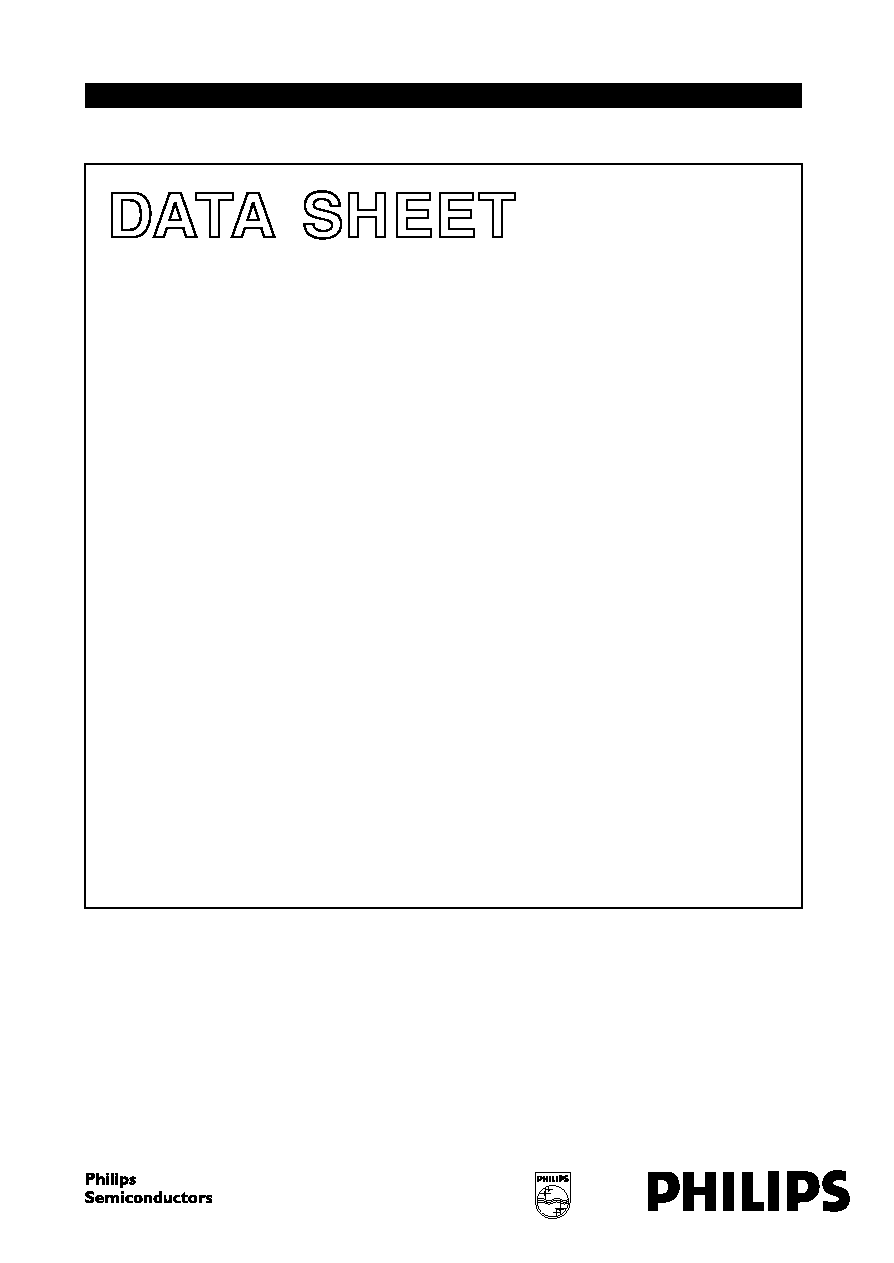
DATA SHEET
Product specification
File under Integrated Circuits, IC03
1997 Jan 13
INTEGRATED CIRCUITS
PCD3332-2; PCD3332-3;
PCD3332-S
Multistandard pulse/tone repertory
diallers/ringers

1997 Jan 13
2
Philips Semiconductors
Product specification
Multistandard pulse/tone repertory
diallers/ringers
PCD3332-2; PCD3332-3;
PCD3332-S
CONTENTS
1
FEATURES
2
GENERAL DESCRIPTION
3
ORDERING INFORMATION
4
PINNING
4.1
PCD3332-2
4.2
PCD3332-3
4.3
PCD3332-S
5
FUNCTIONAL DESCRIPTION
5.1
Pin description
5.1.1
Supply terminals (V
DD
and V
SS
)
5.1.2
Oscillator input/output (XTAL1 and XTAL2)
5.1.3
Chip enable and frequency discriminator input
(CE/FDI)
5.1.4
Cradle switch input (CSI)
5.1.5
Reset input (RESET)
5.1.6
Pulse dial and flash output (DP/FL)
5.1.7
Mute output (MUTE)
5.1.8
DTMF output (TONE)
5.1.9
Register recall (EARTH)
5.1.10
Ringer Tone Enable (RTE: PCD3332-2/S)
5.1.11
Hands-Free/Ringer Tone Enable
(HF/RTE: PCD3332-3)
5.1.12
Volume control outputs (VOL1 and VOL2)
5.1.13
Ringer volume settings
5.1.14
Dial Mode Output /Key-Tone Enable
(DMO/KTE)
5.1.15
Keyboard inputs/outputs
5.2
Keyboards
5.2.1
Keyboard function keys
5.2.2
Diode options
5.2.3
Hook modes
6
OPERATING PROCEDURES
6.1
Operating modes
6.1.1
On-hook mode or ringer mode
6.1.2
Dial mode
6.1.3
Reset delay time
6.1.4
Programming mode
6.1.5
Ringer mode (PCD3332-2)
6.1.6
Ringer mode (PCD3332-3/S)
7
LIMITING VALUES
8
CHARACTERISTICS
9
PACKAGE OUTLINES
10
SOLDERING
10.1
Introduction
10.2
DIP
10.2.1
Soldering by dipping or by wave
10.2.2
Repairing soldered joints
10.3
SO
10.3.1
Reflow soldering
10.3.2
Wave soldering
10.3.3
Repairing soldered joints
11
DEFINITIONS
12
LIFE SUPPORT APPLICATIONS

1997 Jan 13
3
Philips Semiconductors
Product specification
Multistandard pulse/tone repertory
diallers/ringers
PCD3332-2; PCD3332-3;
PCD3332-S
1
FEATURES
·
Pulse, DTMF and VT `mixed mode' dialling
·
13 number repertory dial, up to 32 digits per number
10 one-touch redial or 3 one-touch plus 10 two-touch
250 digits maximum storage
·
Last number redial up to 32 digits
·
Repertory and redial memory integrity check (memory
contents check)
·
Notepad memory function
·
Flash and Earth register recall
·
Access pause generation and termination
·
On-chip power-on reset
·
Supports function keys as follows:
STORE: Program/Store
MRC: Memory Recall
FLASH: calibrated line-break pulse
LNR: Last Number Redial
PAUSE: insert access pause between stored digits
TONE: change from pulse to DTMF dialling (mixed
mode)
VOL+/
-
: speaker/ringer volume control
10 dedicated memory keys
·
Strap functions (diode options):
MLA: Memory Location Access selection
RDS: Enable/Disable ringer validation delay
(PCD3332-2)
DOO: enable/disable transmission
or #
(PCD3332-3/S)
F/E: register recall Flash or Earth
M/S: Mark-to-Space ratio selection (3 : 2 or 2 : 1)
APT: Access Pause Timing selection
TBT: Tone Burst Time selection
FTS: Flash Time Selection
P/T: Pulse or Tone (DTMF) mode selection
RMS: Ringer Melody Selection (PCD3332-2 and
PCD3332-S)
RFS: Ringer input frequency range selection
(19.5 to 57 Hz or 14.4 to 68 Hz) (PCD3332-3)
·
Ringer tone generator
·
Ringer-input frequency discriminator
·
Ringer melody selection via keypad
·
Volume control for loudspeaker phones (PCD3332-3)
·
On-hook dialling/hands-free mode control (PCD3332-3)
·
Pacifier tones.
2
GENERAL DESCRIPTION
The PCD3332-2, PCD3332-3 and PCD3332-S are
mixed-mode multistandard repertory dialler/ringer ICs,
fabricated in a low threshold voltage CMOS technology.
Dial parameters of these ICs can be set by diode options
to meet the specific requirements for various countries.
The on-chip tone generators are used for DTMF dialling
and ringer melody generation. A discriminator input
enables the tone output only if a correct ringer frequency
is applied. Repertory numbers of up to 32 digits can be
stored, with maximum storage of 250 digits.
3
ORDERING INFORMATION
TYPE
NUMBER
PACKAGE
NAME
DESCRIPTION
VERSION
PCD3332-2P
DIP28
plastic dual in-line package; 28 leads (600 mil)
SOT117-1
PCD3332-2T
SO28
plastic small outline package; 28 leads; body width 7.5 mm
SOT136-1
PCD3332-3P
DIP28
plastic dual in-line package; 28 leads (600 mil)
SOT117-1
PCD3332-3T
SO28
plastic small outline package; 28 leads; body width 7.5 mm
SOT136-1
PCD3332-SP
DIP28
plastic dual in-line package; 28 leads (600 mil)
SOT117-1
PCD3332-ST
SO28
plastic small outline package; 28 leads; body width 7.5 mm
SOT136-1

1997 Jan 13
4
Philips Semiconductors
Product specification
Multistandard pulse/tone repertory
diallers/ringers
PCD3332-2; PCD3332-3;
PCD3332-S
4
PINNING
4.1
PCD3332-2
Notes on types and initial states of inputs and outputs
1. Standard input or output, set to HIGH state.
2. Open-drain output, set to HIGH state.
3. Open-drain output, reset to LOW state.
4. Push-pull output, reset to LOW state.
SYMBOL
PIN
TYPE
DESCRIPTION
ROW2
1
I/O
(1)
row 2 keyboard output
ROW3
2
I/O
(1)
row 3 keyboard output
ROW4
3
I/O
(1)
row 4 keyboard output
ROW5
4
O
(2)
row 5 keyboard output
DIODE
5
I/O
(1)
diode option
MUTE
6
O
(4)
mute output
EARTH
7
O
(4)
earth recall
CSI
8
I
cradle switch input
XTAL1
9
I
oscillator input
XTAL2
10
O
oscillator output
RESET
11
I
reset input
CE/FDI
12
I
chip enable/frequency discriminator
COL6
13
I/O
(1)
column 6 input
COL5
14
I/O
(1)
column 5 input
COL4
15
I/O
(1)
column 4 input
COL3
16
I/O
(1)
column 3 input
COL2
17
I/O
(1)
column 2 input
COL1
18
I/O
(1)
column 1 input
DP/FL
19
O
(2)
dial pulse/flash output
not used
20
O
(4)
not used, leave pin unconnected
VOL2
21
O
(3)
volume 2 output
V
SS
22
P
ground
TONE
23
O
tone generator output
V
DD
24
P
positive supply voltage
VOL1
25
O
(3)
volume 1 output
DMO/KTE
26
O
(4)
dial mode output
RTE
27
O
(4)
key/ringer tone enable
ROW1
28
I/O
(1)
row 1 keyboard output
Fig.1 Pin configuration.
age
PCD3332-2
MBE757
1
2
3
4
5
6
7
8
9
10
11
12
13
14
28
27
26
25
24
23
22
21
20
19
18
17
16
15
ROW2
ROW3
ROW4
ROW5
DIODE
MUTE
EARTH
CSI
XTAL1
XTAL2
RESET
CE/FDI
COL6
COL5
ROW1
RTE
DMO/KTE
VOL1
VDD
TONE
VSS
VOL2
not used
DP/FL
COL1
COL2
COL3
COL4
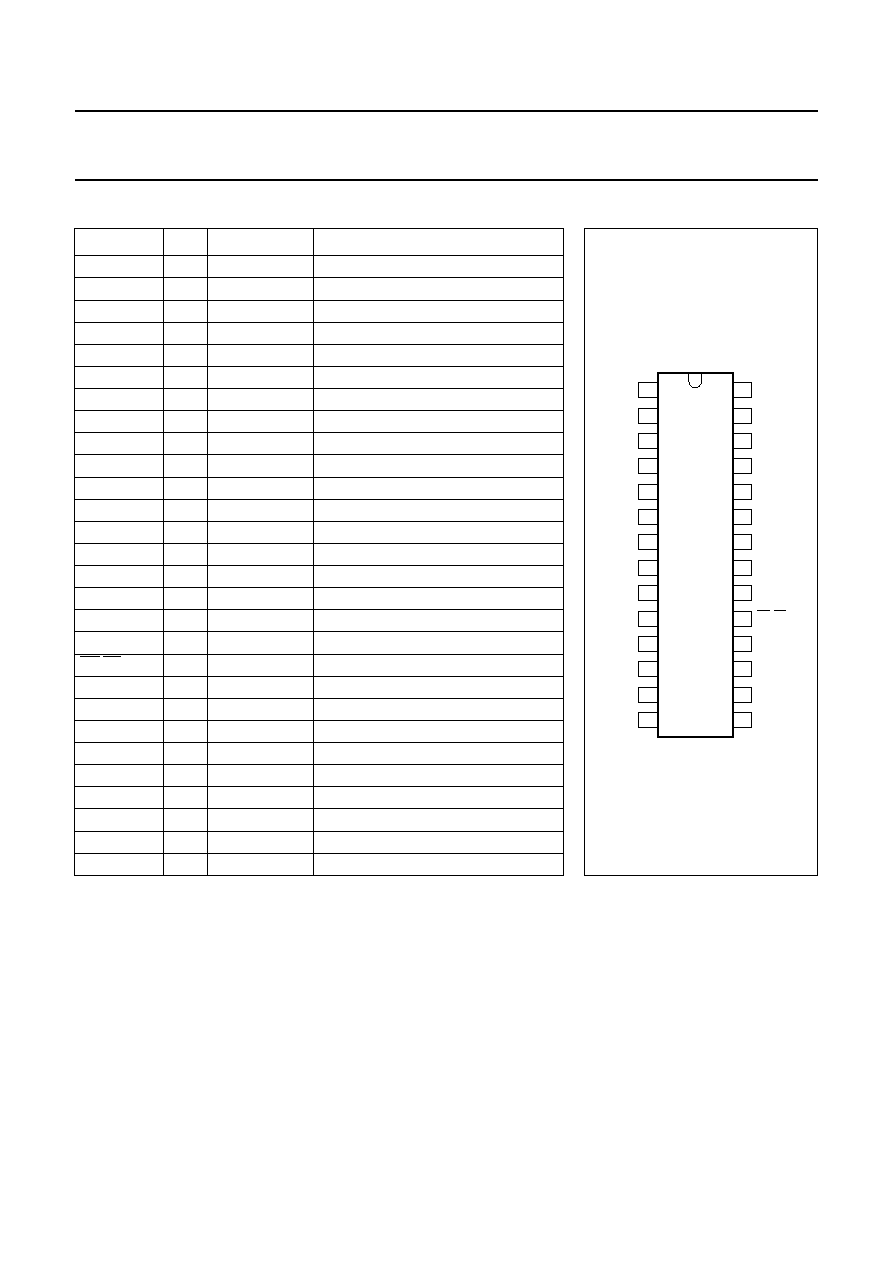
1997 Jan 13
5
Philips Semiconductors
Product specification
Multistandard pulse/tone repertory
diallers/ringers
PCD3332-2; PCD3332-3;
PCD3332-S
4.2
PCD3332-3
Notes on types and initial states of inputs and outputs
1. Standard input or output, set to HIGH state.
2. Open-drain output, set to HIGH state.
3. Open-drain output, reset to LOW state.
4. Push-pull output, reset to LOW state.
SYMBOL
PIN
TYPE
DESCRIPTION
ROW2
1
I/O
(1)
row 2 keyboard output
ROW3
2
I/O
(1)
row 3 keyboard output
ROW4
3
I/O
(1)
row 4 keyboard output
ROW5
4
O
(2)
row 5 keyboard output
DIODE
5
I/O
(1)
diode option
MUTE
6
O
(4)
mute output
EARTH
7
O
(4)
earth recall
CSI
8
I
cradle switch input
XTAL1
9
I
oscillator input
XTAL2
10
O
oscillator output
RESET
11
I
reset input
CE/FDI
12
I
chip enable/frequency discriminator
COL6
13
I/O
(1)
column 6 input
COL5
14
I/O
(1)
column 5 input
COL4
15
I/O
(1)
column 4 input
COL3
16
I/O
(1)
column 3 input
COL2
17
I/O
(1)
column 2 input
COL1
18
I/O
(1)
column 1 input
DP/FL
19
O
(2)
dial pulse/flash output
LFE
20
O
(4)
low-frequency amplifier enable
VOL2
21
O
(3)
volume 2 output
V
SS
22
P
ground
TONE
23
O
tone generator output
V
DD
24
P
positive supply voltage
VOL1
25
O
(3)
volume 1 output
DMO/KTE
26
O
(4)
dial mode output
HF/RTE
27
O
(4)
hands-free/ringer tone enable
ROW1
28
I/O
(1)
row 1 keyboard output
Fig.2 Pin configuration.
age
PCD3332-3
MBE752
1
2
3
4
5
6
7
8
9
10
11
12
13
14
28
27
26
25
24
23
22
21
20
19
18
17
16
15
ROW2
ROW3
ROW4
ROW5
DIODE
MUTE
EARTH
CSI
XTAL1
XTAL2
RESET
CE/FDI
COL6
COL5
ROW1
HF/RTE
DMO/KTE
VOL1
VDD
TONE
VSS
VOL2
LFE
DP/FL
COL1
COL2
COL3
COL4

1997 Jan 13
6
Philips Semiconductors
Product specification
Multistandard pulse/tone repertory
diallers/ringers
PCD3332-2; PCD3332-3;
PCD3332-S
4.3
PCD3332-S
Notes on types and initial states of inputs and outputs
1. Standard input or output, set to HIGH state.
2. Open-drain output, set to HIGH state.
3. Open-drain output, reset to LOW state.
4. Push-pull output, reset to LOW state.
SYMBOL
PIN
TYPE
DESCRIPTION
ROW2
1
I/O
(1)
row 2 keyboard output
ROW3
2
I/O
(1)
row 3 keyboard output
ROW4
3
I/O
(1)
row 4 keyboard output
ROW5
4
O
(2)
row 5 keyboard output
DIODE
5
I/O
(1)
diode option
MUTE
6
O
(4)
mute output
EARTH
7
O
(4)
earth recall
CSI
8
I
cradle switch input
XTAL1
9
I
oscillator input
XTAL2
10
O
oscillator output
RESET
11
I
reset input
CE/FDI
12
I
chip enable/frequency discriminator
COL6
13
I/O
(1)
column 6 input
COL5
14
I/O
(1)
column 5 input
COL4
15
I/O
(1)
column 4 input
COL3
16
I/O
(1)
column 3 input
COL2
17
I/O
(1)
column 2 input
COL1
18
I/O
(1)
column 1 input
DP/FL
19
O
(2)
dial pulse/flash output
not used
20
O
(4)
not used, leave pin unconnected
VOL2
21
O
(3)
volume 2 output
V
SS
22
P
ground
TONE
23
O
tone generator output
V
DD
24
P
positive supply voltage
VOL1
25
O
(3)
volume 1 output
DMO/KTE
26
O
(4)
dial mode output
RTE
27
O
(4)
key/ringer tone enable
ROW1
28
I/O
(1)
row 1 keyboard output
Fig.3 Pin configuration.
page
PCD3332-S
MBE754
1
2
3
4
5
6
7
8
9
10
11
12
13
14
28
27
26
25
24
23
22
21
20
19
18
17
16
15
ROW2
ROW3
ROW4
ROW5
DIODE
MUTE
EARTH
CSI
XTAL1
XTAL2
RESET
CE/FDI
COL6
COL5
ROW1
RTE
DMO/KTE
VOL1
VDD
TONE
VSS
VOL2
not used
DP/FL
COL1
COL2
COL3
COL4
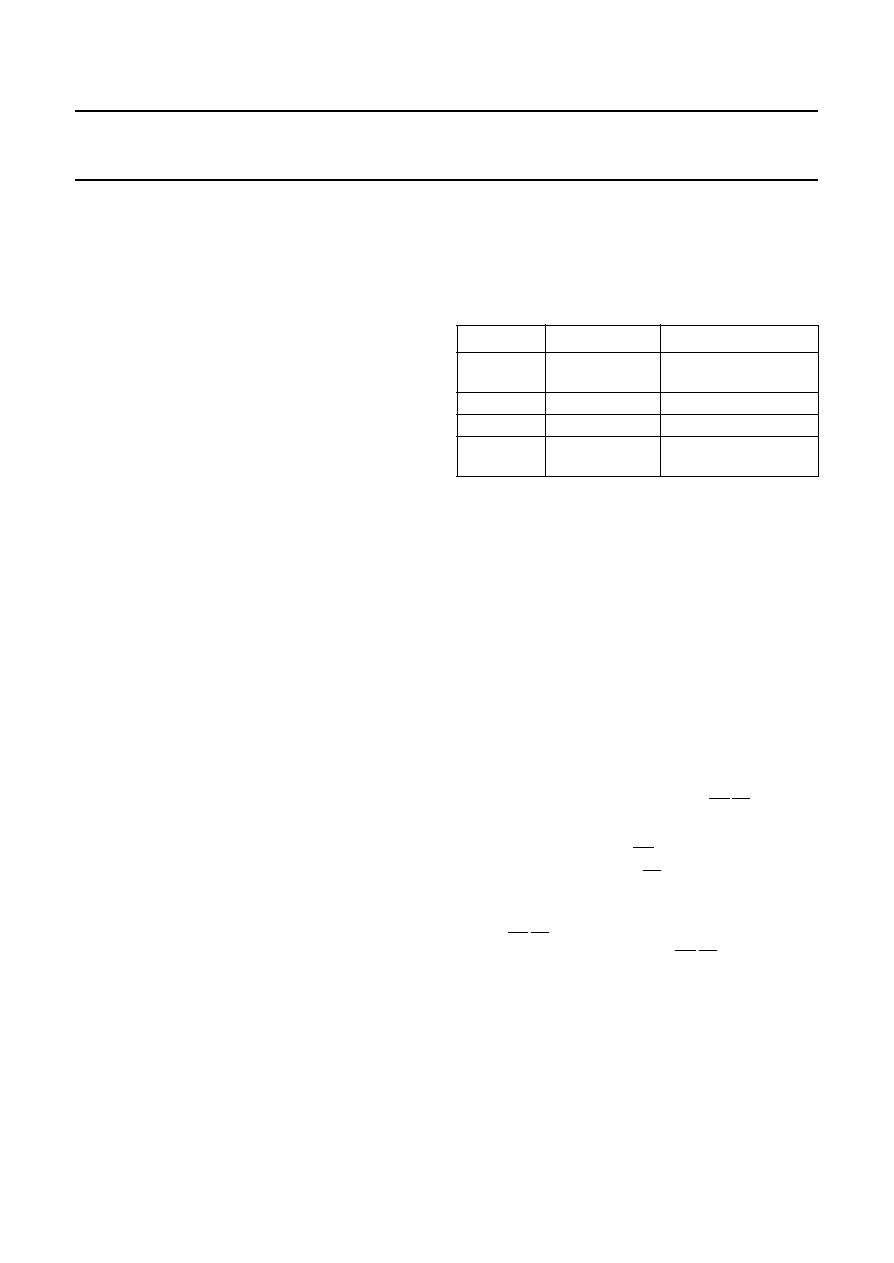
1997 Jan 13
7
Philips Semiconductors
Product specification
Multistandard pulse/tone repertory
diallers/ringers
PCD3332-2; PCD3332-3;
PCD3332-S
5
FUNCTIONAL DESCRIPTION
References to the `PCD3332' or the `device' apply to the
PCD3332-2, the PCD3332-3 and the PCD3332-S.
5.1
Pin description
5.1.1
S
UPPLY TERMINALS
(V
DD
AND
V
SS
)
To retain data in the RAM, the standby supply voltage of
1 V, must be maintained. To ensure that the contents of
the RAM are secure in the event of a power failure, a
capacitor may be connected across the supply terminals.
The capacitor must have a suitable value to maintain the
standby voltage for a certain period of time. The minimum
operating voltage of these devices is 2.5 V. The internal
power-on reset is enabled for a voltage below this
minimum operating voltage.
5.1.2
O
SCILLATOR INPUT
/
OUTPUT
(XTAL1
AND
XTAL2)
The time base for the PCD3332 is a crystal-controlled
on-chip oscillator, which incorporates a 3.58 MHz crystal
or ceramic resonator connected between XTAL1 and
XTAL2. It should be noted that when using a ceramic
resonator, the minimum supply voltage increases.
The oscillator starts when V
DD
reaches its operating
voltage level and CE = HIGH (min. 2.5 V).
5.1.3
C
HIP ENABLE AND FREQUENCY DISCRIMINATOR
INPUT
(CE/FDI)
For DC inputs this pin acts as the chip enable (CE) input,
and is active HIGH. CE in combination with the Cradle
Switch Input (CSI) determines the mode of the device.
See Table 1.
For AC inputs the pin acts as the (ringer) Frequency
Discriminator Input (FDI).
To generate a correct ringer output tone, the input
frequency must be between 19.5 Hz and 57 Hz;
frequencies below 18 Hz and higher than 64 Hz are
omitted.
The PCD3332-3 has a second (diode selectable) range of
valid input frequencies of 14.5 Hz to 68 Hz; frequencies
below 14 Hz and higher than 76 Hz are omitted.
Ringer response timing and detection is illustrated in
Fig.15.
5.1.4
C
RADLE SWITCH INPUT
(CSI)
CSI is normally generated from the physical `off-hooking'
of the phone. CSI in combination with CE/FDI determines
the operating mode of the PCD3332, as shown in Table 1.
Table 1
Different modes of the PCD3332
5.1.5
R
ESET INPUT
(RESET)
RESET activates the on-chip reset circuit and is active
HIGH. The reset circuit initializes all inputs and outputs.
Two other events will cause the chip to initialize:
·
CE going HIGH
·
V
DD
falling below 2.5 V, then being restored (power-on
reset).
For this reason, RESET may not be required, and can be
connected to V
SS
. This should preferably be via a 100 k
resistor, to save leakage current.
Note that a suitable capacitor connected between V
DD
and
V
SS
will inhibit the decrease of voltage at V
DD
after a power
failure, and thus extend the time until the power-on reset is
initiated.
5.1.6
P
ULSE DIAL AND FLASH OUTPUT
(DP/FL)
This pin is the output for:
·
The dial pulse sequence (DP)
·
The calibrated LOW pulse (FL) after the FLASH key is
pressed.
The dialling sequence for pulse dialling is shown in Figs 11
and 12. DP/FL starts HIGH, pulses are LOW, and the
inter-digit pauses are HIGH. Thus, DP/FL is HIGH during
a line-make and LOW during a line-break.
If the Flash/Earth diode option is set to FLASH, then when
FLASH is pressed a LOW pulse is output, with a calibrated
duration also determined by diode option.
INPUT CSI
INPUT CE/FDI
PCD3332 STATUS
LOW
LOW
stop or power-down
mode
HIGH
LOW
idle mode
LOW
HIGH
ringer mode
HIGH
HIGH
conversation or
off-hook mode
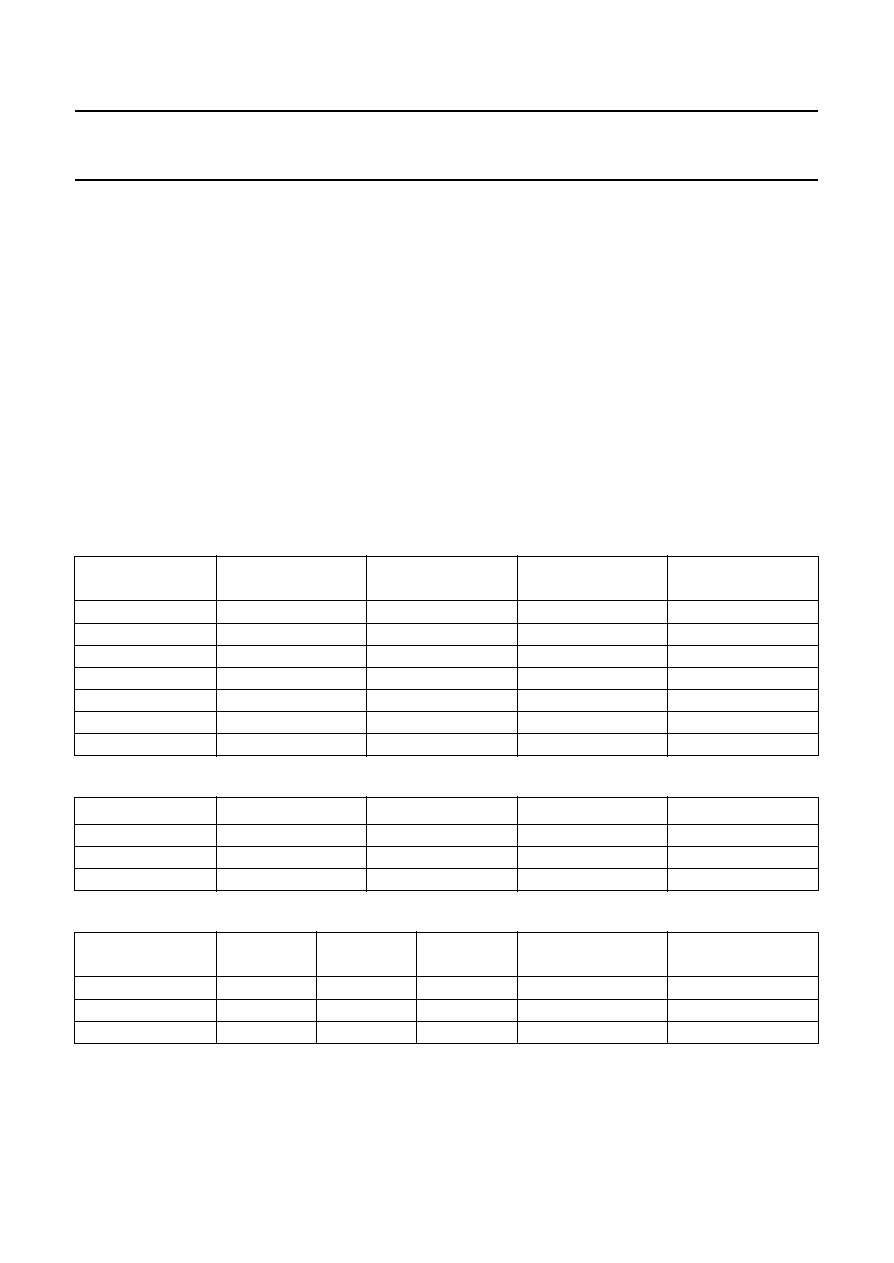
1997 Jan 13
8
Philips Semiconductors
Product specification
Multistandard pulse/tone repertory
diallers/ringers
PCD3332-2; PCD3332-3;
PCD3332-S
5.1.7
M
UTE OUTPUT
(MUTE)
During the dialling sequence this push-pull output is
activated. In the pulse dialling mode, MUTE goes HIGH
prior to the dialling action and goes LOW after the last
t
idp
(interdigit pause), see Figs 11 and 12. In DTMF
dialling, MUTE goes HIGH prior to the dialling action and
goes LOW after an additional `holdover' time, see
Figs 13 and 14.
This output is also activated if the device enters the
programming mode, to avoid transmitting the keys
entered.
5.1.8
DTMF
OUTPUT
(TONE)
The timing sequence for DTMF dialling is illustrated in
Figs 13 and 14. The tones generated by this TONE are
filtered by an on-chip switched capacitor filter, and active
RC low-pass filter. Therefore, the total harmonic distortion
fulfils the CEPT CS203 recommendations. An on-chip
reference voltage provides output tone levels independent
of supply voltages and temperatures. Spread among the
individual parts is extremely low.
The DC level of the TONE output measures 0.5V
DD
and
the impedance is 100
(typ.). Table 2 shows the
frequency tolerances.
The TONE output is also used to generate the ringer
melody, key entry acceptance beep, error or warning
beeps and confirmation beeps. These beeps are
generated/set in programming mode as a response to the
users action. The ringer is designed to generate
3-melodies that may be selected using the keyboard.
Table 3 shows the implemented ringer melodies.
Table 2
DTMF frequency tolerances
Table 3
Ringer melodies
Table 4
Beep frequencies
ROW/COL
STANDARD
FREQUENCY (Hz)
OUTPUT
FREQUENCY (Hz)
DEVIATION
(%)
DEVIATION
(Hz)
ROW 1
697
697.90
+0.13
+0.90
ROW 2
770
770.46
+0.06
+0.46
ROW 3
852
852.45
-
0.18
-
1.55
ROW 4
941
943.23
+0.24
+2.23
COL 1
1209
1206.45
-
0.21
-
2.55
COL 2
1336
1341.66
+0.42
+5.66
COL 3
1477
1482.21
+0.35
+5.21
KEY DEPRESSED
TONE 1 (Hz)
TONE 2 (Hz)
TONE 3 (Hz)
TONE ON TIME (ms)
1
826
925
1037
30
2
1037
1161
1297
30
3
1297
1455
1621
30
BEEP FUNCTION
TONE 1 (Hz)
TONE 2 (Hz)
TONE 3 (Hz)
TONE ON TIME (ms)
TONE OFF TIME
(ms)
Key accept
2358
-
-
40
-
Error
2358
2358
2358
134
35
Confirmation
806
899
1010
134
67

1997 Jan 13
9
Philips Semiconductors
Product specification
Multistandard pulse/tone repertory
diallers/ringers
PCD3332-2; PCD3332-3;
PCD3332-S
5.1.9
R
EGISTER RECALL
(EARTH)
If the Flash/Earth diode option of the PCD3332 is set to the
Earth, then dialling the EARTH either out of
Repertory/LNR or by pressing the FLASH key will
generate a HIGH pulse at the push-pull output EARTH for
a calibrated time. Figures 12 and 14 illustrate the EARTH
timing relationship with other signals. The calibrated
EARTH time is followed by an interdigit time t
idp
. A second
dialling of EARTH can only be performed after the interdigit
time has elapsed.
If the Flash key was the first key depressed directly after
going off-hook, followed by a second depressing of the
Flash key while the EARTH is still in progress, then the
second depression will be ignored.
5.1.10
R
INGER
T
ONE
E
NABLE
(RTE: PCD3332-2/S)
The PCD3332-2 and PCD3332-S generate tones for the
ringer output stage and key tones when depressing a
function key at the keypad. Output RTE will go HIGH and
stay HIGH for the duration of the tone generated at output
TONE.
5.1.11
H
ANDS
-F
REE
/R
INGER
T
ONE
E
NABLE
(HF/RTE:
PCD3332-3)
The PCD3332-3 generates tones for the ringer output
stage and key tones when depressing a function key at the
keypad. Output HF/RTE will go HIGH and stay HIGH for
the duration of the tone generated at output TONE.
During the conversation mode, HF/RTE is used for
enabling the hands-free mode. Depressing the HOOK key
will change the operation mode as follows:
·
Change from on-hook (stop mode) to hands-free mode
·
Toggles the listening-in mode
·
Change from handset to hands-free.
5.1.12
V
OLUME CONTROL OUTPUTS
(VOL1
AND
VOL2)
5.1.12.1
PCD3332-2
The PCD3332-2 has the facility to control the ringer output
signal, as well as the loudspeaker volume, by depressing
the keys
/VOL
-
or #/ VOL+ during the ringer mode.
If the maximum volume level is reached, depressing
#/VOL+ key will not change the volume setting. If the
minimum volume level is reached, depressing
/VOL
-
key
will not change the volume setting. Selection between
ringer volume or conversation mode volume, is performed
in the hardware using the RTE output. In the ringer mode
the output RTE is HIGH.
Table 5 shows the volume outputs setting, as well as the
default setting in case of a power failure or if the power is
supplied for the first time.
5.1.12.2
PCD3332-3
The PCD3332-3 has the facility to control the ringer output
signal and the loudspeaker signal during listening-in or
hands-free operation. Depressing the keys VOL
-
or VOL+
during the ringer mode will change the ringer volume
setting. Depressing the keys VOL
-
or VOL+ during the
conversation mode will change the loudspeaker volume
setting.
If the maximum volume level is reached, depressing the
VOL+ key will not change the volume setting. If the
minimum volume level is reached, depressing the VOL
-
key will not change the volume setting. Selection between
ringer volume or conversation mode volume, is performed
in the hardware using the HF/RTE output. In the ringer
mode the output HF/RTE is HIGH.
Table 5 shows the volume outputs setting, as well as the
default setting in case of a power failure or if the power is
supplied for the first time.
5.1.12.3
PCD3332-S
The PCD3332-S has the facility to control the ringer output
signal by depressing the keys VOL
-
or VOL+ during the
ringer mode.
If the maximum volume level is reached, depressing the
VOL+ key will not change the volume setting. If the
minimum volume level is reached, depressing the VOL
-
key will not change the volume setting. Selection between
ringer volume or conversation mode volume, is performed
in the hardware using the RTE output. In the ringer mode
the output RTE is HIGH.
Table 5 shows the volume outputs setting, as well as the
default setting in case of a power failure or if the power is
supplied for the first time.
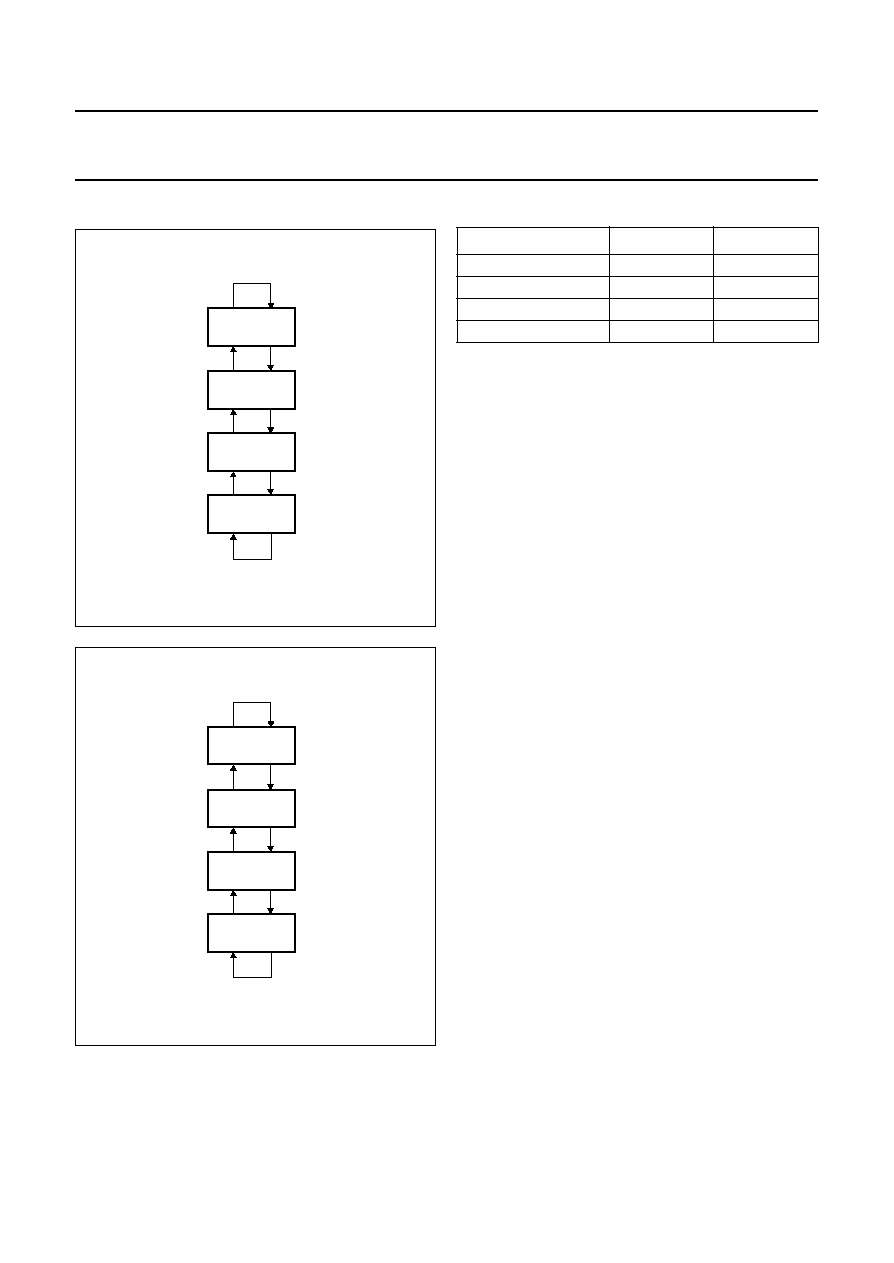
1997 Jan 13
10
Philips Semiconductors
Product specification
Multistandard pulse/tone repertory
diallers/ringers
PCD3332-2; PCD3332-3;
PCD3332-S
5.1.13
R
INGER VOLUME SETTINGS
Fig.4 FSM for volume control (PCD3332-2).
handbook, halfpage
DEFAULT
VOLUME
HIGH
VOLUME
LOW
VOLUME
VOL
+
/#
VOL
+
/#
VOL
+
/#
VOL
+
/#
VOL
-
/
*
VOL
-
/
*
VOL
-
/
*
VOL
-
/
*
LOWEST
VOLUME
MGC616
Fig.5 FSM for volume control (PCD3332-3/S).
handbook, halfpage
DEFAULT
VOLUME
HIGH
VOLUME
LOW
VOLUME
VOL
+
VOL
+
VOL
+
VOL
+
VOL
-
VOL
-
VOL
-
VOL
-
LOWEST
VOLUME
MGC615
Table 5
State assignment
5.1.14
D
IAL
M
ODE
O
UTPUT
/K
EY
-T
ONE
E
NABLE
(DMO/KTE)
In the PULSE dialling mode the DMO/KTE output is
activated (HIGH), at dialling the Make/Brake pulse dial
sequences. Figures 11 and 12 illustrate the signal timing
relationship.
In the programming mode, the DMO/KTE output is
activated at the same time the key beeps are generated at
output TONE and may be used to enable the key tone to
the earpiece amplifier.
5.1.15
K
EYBOARD INPUTS
/
OUTPUTS
A single contact keyboard with a maximum of 6 columns
and 5 rows can be connected to the PCD3332-2.
The keyboard scanning is started if a key depression is
detected. The rows are scanned while the columns are
used as sense inputs.
To overcome key bouncing, a debounce on/off time of
approximately 14 to 20 ms is implemented.
Only one single key depression is validated and accepted
at any one time. Once a key is accepted the keyboard
scanning is continued until no further keys are depressed.
This means that if a key is accepted but still depressed
while a second key is entered, the second key depression
is ignored. Also, if two or more keys are depressed within
the debounce time while no key is yet accepted, all keys
are ignored.
Keyboard detection is also performed in the ringer mode to
enable the ringer volume setting and ringer melody
selection.
In the on-hook mode or power-down mode of the
PCD3332-2 and PCD3332-S, the keyboard I/Os are set to
HIGH except ROW 5 which is set to LOW.
STATE
VOL2
VOL1
Default volume setting
HIGH
HIGH
High volume setting
HIGH
LOW
Low volume setting
LOW
HIGH
Lowest volume setting
LOW
LOW

1997 Jan 13
11
Philips Semiconductors
Product specification
Multistandard pulse/tone repertory
diallers/ringers
PCD3332-2; PCD3332-3;
PCD3332-S
In the on-hook mode or power-down mode of the
PCD3332-3, the keyboard I/Os are set to HIGH except
ROW 5 which is set to LOW. In this instance, depression
of the HOOK key can be detected by the external
hardware circuitry and converted to an active HIGH signal
which is passed to CE in order to `wake-up' the
PCD3332-3.
When the HOOK key has been accepted the PCD3332-3
enters the hands-free mode.
ROW 5 was used to detect the HOOK key, this function is
deleted.
ROW 5 is an open-drain input, this configuration is used to
avoid current flowing in the on-hook mode or power-down
mode. A pull-up resistor should be connected to ROW 5.
The keyboards which the PCD3332-2, PCD3332-3 and
PCD33332-S support are shown in Figs 6, 7 and 8
respectively. The figures also show the diode options as
`dotted' keys.
5.2
Keyboards
Fig.6 Keyboard layout (PCD3332-2).
handbook, full pagewidth
1
4
7
*
FLASH
M/S
2
5
8
0
PAUSE
F/E
3
6
9
#
LNR
RDS
STORE
TONE
VOL
VOL
MLA
M1
M3
M5
M7
M9
APT
M2
M4
MRC
M6
M8
M10
PTS
FTS A
FTS B
TBT A
TBT B
RMS
MBE756
ROW 1
ROW 2
ROW 3
ROW 4
ROW 5
COL 1
COL 2
COL 3
COL 4
COL 5
Diode
COL 6
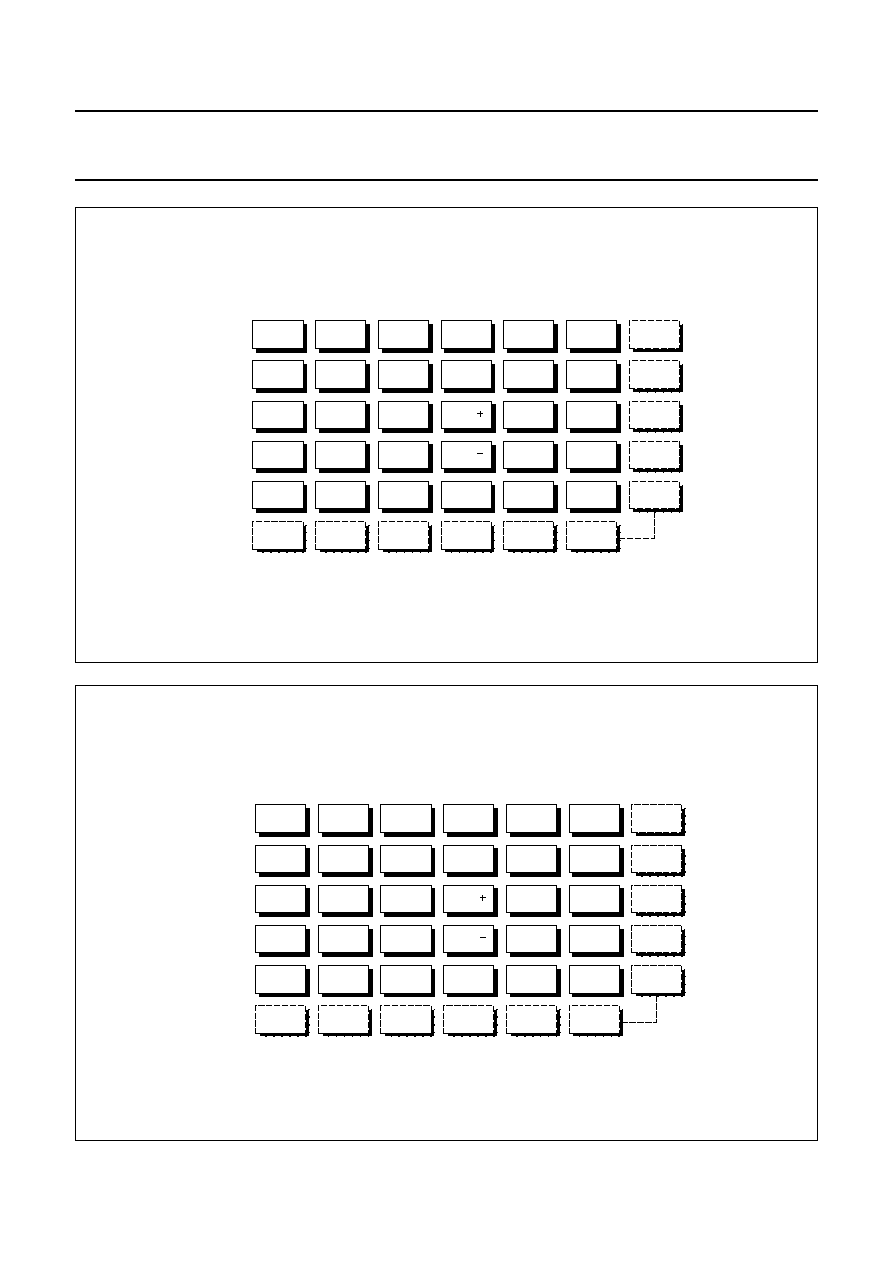
1997 Jan 13
12
Philips Semiconductors
Product specification
Multistandard pulse/tone repertory
diallers/ringers
PCD3332-2; PCD3332-3;
PCD3332-S
Fig.7 Keyboard layout (PCD3332-3).
handbook, full pagewidth
1
4
7
*
FLASH
M/S
2
5
8
0
PAUSE
F/E
3
6
9
#
LNR
DOO
STORE
TONE
VOL
VOL
HOOK
MLA
M1
M3
M5
M7
M9
APT
M2
M4
MRC
M6
M8
M10
PTS
FTS A
FTS B
TBT A
TBT B
RFS
MBE751
ROW 1
ROW 2
ROW 3
ROW 4
ROW 5
COL 1
COL 2
COL 3
COL 4
COL 5
Diode
COL 6
Fig.8 Keyboard layout (PCD3332-S).
handbook, full pagewidth
1
4
7
*
FLASH
M/S
2
5
8
0
PAUSE
F/E
3
6
9
#
LNR
DOO
STORE
TONE
VOL
VOL
MLA
M1
M3
M5
M7
M9
APT
M2
M4
MRC
M6
M8
M10
PTS
FTS A
FTS B
TBT A
TBT B
RMS
MBE755
ROW 1
ROW 2
ROW 3
ROW 4
ROW 5
COL 1
COL 2
COL 3
COL 4
COL 5
Diode
COL 6
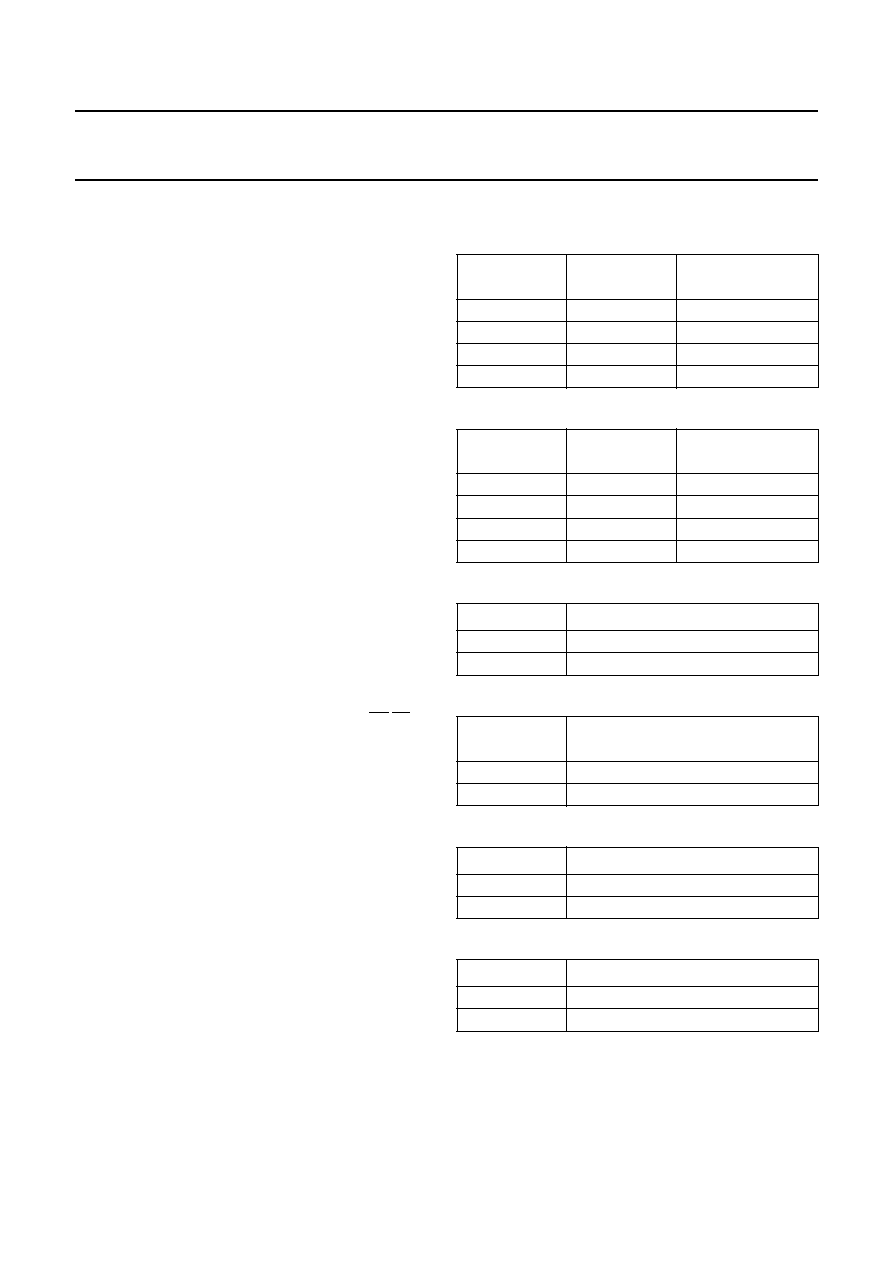
1997 Jan 13
13
Philips Semiconductors
Product specification
Multistandard pulse/tone repertory
diallers/ringers
PCD3332-2; PCD3332-3;
PCD3332-S
5.2.1
K
EYBOARD FUNCTION KEYS
5.2.1.1
LNR
If the first key operated after CE = HIGH (off-hook) is key
LNR the PCD3332 will transmit the last number dialled
before CE was LOW (on-hook).
5.2.1.2
PAUSE
Pressing the PAUSE key will insert an access pause
during manual dialling and/or during programming. During
manual dialling the pause time is not dialled, but is stored
in the redial memory. This means that with manual dialling
the user actually waits for the dial tone before dialling is
continued. Repertory and LNR dialling however, will dial
out the access pause. If the pause key is depressed while
an access pause is being dialled, the access pause in
progress is terminated and dialling will continue at the next
non-access pause digit. The access pause duration is
option selectable.
5.2.1.3
TONE (mixed mode dialling)
If the pulse dial mode is selected by the diode option, then
pressing the `TONE', `
' or `#' keys will change the dial
mode to DTMF. Pressing the Flash key or going on-hook
will restore the pulse dial mode.
5.2.1.4
RECALL (Flash or Earth)
Depressing the FLASH key will activate output DP/FL or
output EARTH for the calibrated time, depending on which
function Flash or Earth is selected.
5.2.1.5
STORE
Pressing the STORE key will start/stop the programming
mode. To inhibit transmitting the key entries while in
programming mode, the output and MUTE is activated.
5.2.1.6
MRC
In order to access one of the memory locations, the MRC
key must be depressed followed by one of the numerical
keys 0 to 9. To enable the MRC key, diode option MLA
must be disconnected.
5.2.1.7
VOL
-
and VOL
+
For the PCD3332-3's `hands-free' and `listening-in' modes,
where the loudspeaker is on, the VOL keys control the
loudspeaker volume. In the ringer mode (all devices), the
VOL keys control the ringer volume.
At power-on reset a default volume is preset for both the
loudspeaker and the ringer volume.
5.2.2
D
IODE OPTIONS
Table 6
Tone Burst Time diode configuration
Table 7
Flash time select diode configuration
Table 8
Flash/Earth diode configuration
Table 9
Mark/space diode configuration
Table 10 Pulse/tone diode configuration
Table 11 Access Pause Time diode configuration
TBT A
DIODE
TBT B
DIODE
SELECTED
TIMING (ms)
Not connected
not connected
70/70
Not connected
connected
100/100
Connected
not connected
85/85
Connected
connected
70/140
FTS A
DIODE
FTS B
DIODE
SELECTED
TIMING (ms)
Not connected
not connected
95
Not connected
connected
115
Connected
not connected
270
Connected
connected
600
F/E DIODE
SELECTED MODE
Not connected
Flash
Connected
Earth (400 ms)
M/S DIODE
SELECTED MAKE/BRAKE RATIO
(ms)
Not connected
33/66 (1 : 2)
Connected
40/60 (2 : 3)
P/T DIODE
SELECTED DIAL MODE
Not connected
DTMF
Connected
Pulse
APT DIODE
SELECTED TIMING (s)
Not connected
2
Connected
4

1997 Jan 13
14
Philips Semiconductors
Product specification
Multistandard pulse/tone repertory
diallers/ringers
PCD3332-2; PCD3332-3;
PCD3332-S
Table 12 Ringer melody selection (PCD3331-2/S)
Table 13 Ringer input frequency selection (PCD3332-3)
Table 14 Memory Location Access diode configuration
Table 15 Ringer Delay Selection diode configuration
(PCD3332-2)
Table 16 DTMF output option diode configuration
(PCD3332-3/S)
5.2.2.1
Ringer Delay Selection (RDS: PCD3332-2)
If the diode is connected, then the actual ringer frequency
validation is started after a delay of 100 ms. This is only
performed at the start of each ringer burst signal.
5.2.2.2
DOO DTMF output selection (PCD3332-3/S)
If the diode is connected, then the
and # DTMF signals
will be dialled out during pulse-to-tone switching. If the
diode is not connected
and # will not be dialled out during
pulse-to-tone switching.
RMS DIODE
RINGER FREQUENCY
SELECTION (Hz)
Not connected
ringer melody selection by
keys 1, 2 and 3
Connected
default ringer melody
RFS DIODE
RINGER FREQUENCY
SELECTION (Hz)
Not connected
19.5 to 54
Connected
14.5 to 68
MLA DIODE
KEY FUNCTION
Not connected
M4/MRC key is MRC
Connected
M4/MRC key is M4
RDS DIODE
OUTPUT SELECTION
Not connected
no delay
Connected
ringer validation delay, 100 ms
DOO DIODE
OUTPUT SELECTION
Not connected
no transmission of
/#
Connected
transmission of
/#
5.2.2.3
Ringer Melody Selection (RMS: PCD3332-2/S)
The ringer melody for these devices can be changed by
depressing keys 1, 2 and 3. To give default melody only,
apply a diode at RMS location.
5.2.2.4
Ringer Input Frequency Range Selection
(RFS: PCD3332-3)
For the PCD3332-3, this diode is used to select between
two input frequency ranges, 19.5 to 54 Hz or
14.5 to 68 Hz.
5.2.2.5
Memory Location Access (MLA)
To be able to build various telephone models by using the
PCD3332, a possibility has been created to define
different keypad layouts. e.g. a 13 number repertory dial
consist of 10 numbers recalled via MRC + 0 to 9, and
3 direct access numbers M1, M2 and M3. A 10 number
direct accessible dialler can be created by applying the
keys M1 to M10 while a diode is connected at the MLA
location.
5.2.2.6
Mark-to-Space ratio (M/S)
Changes the make-break ratio from 60 : 40 ms (3 : 2) to
66 : 33 ms (2 : 1).
5.2.2.7
Access Pause Time (APT)
To adapt the access pause timing to local requirements,
2 different times for DTMF and the corresponding times for
pulse dialling are built-in.
5.2.2.8
Tone Burst Time (TBT)
During automatic transmission of a number in the DTMF
mode the tone-on time and the pause time between two
digits can be selected by option TBT A and TBT B. During
manual dialling this option selects the minimum tone-on
and pause time while the maximum time is determined by
the time a key is depressed.
5.2.2.9
Pulse/Tone mode Selection (PTS)
The telephone set can be initially set to the PULSE or
DTMF mode by switching on and off the diode in the
matrix.
The first entry of keys
and # in the pulse dial mode will
change the dial mode as well.
5.2.2.10
Flash or Earth register recall (F/E)
Dependent on this option, the output DP/FL or output
EARTH will be activated after a flash key operation.
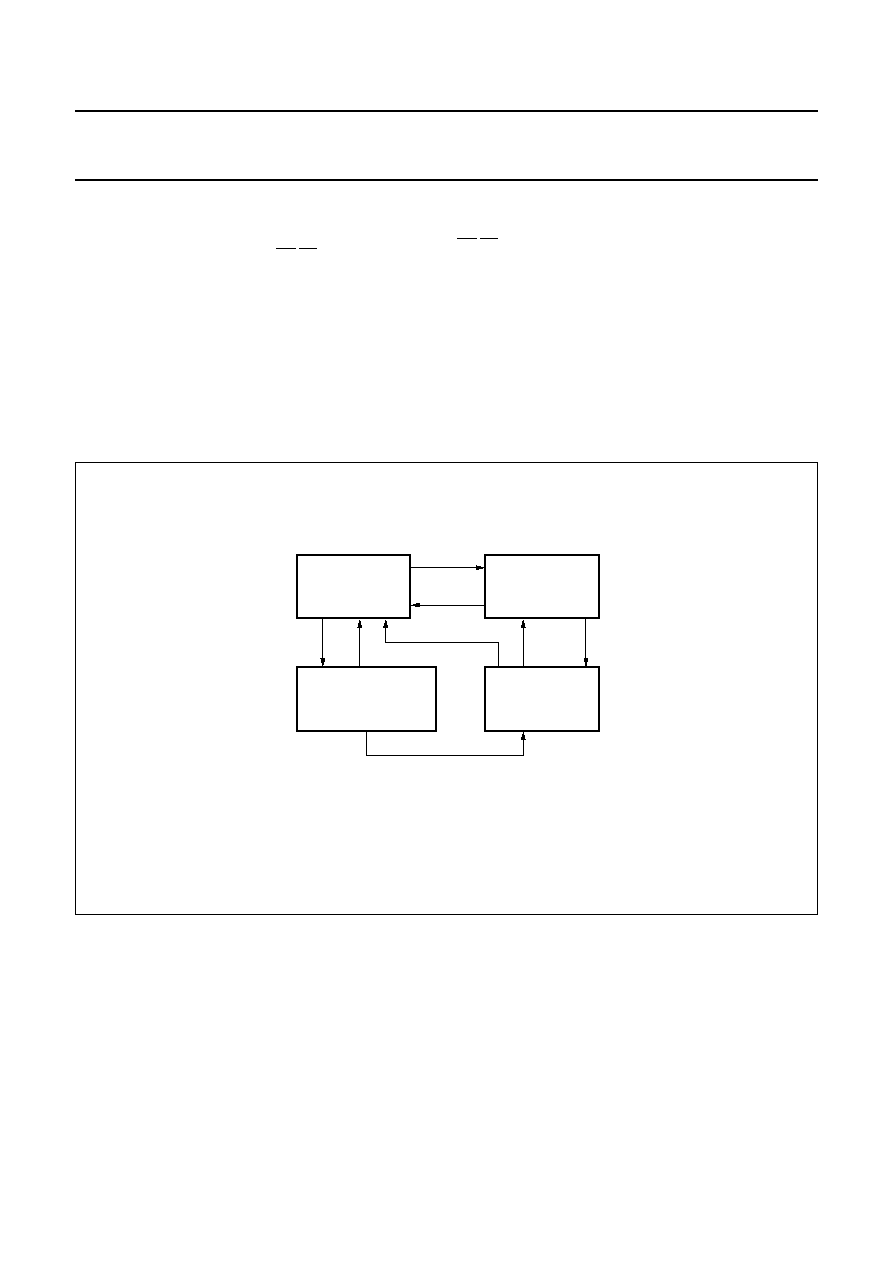
1997 Jan 13
15
Philips Semiconductors
Product specification
Multistandard pulse/tone repertory
diallers/ringers
PCD3332-2; PCD3332-3;
PCD3332-S
5.2.2.11
Flash Time Select
These two diodes set the calibrated flash pulse duration:
100, 115, 270 or 600 ms for the DP/FL output, when this
output is selected. When the EARTH output is selected the
earth pulse is 400 ms.
5.2.2.12
Low Frequency amplifier Enable (LFE:
PCD3332-3)
Output LFE can be used to enable the TEA108x or
TEA109x listening-in or hands-free IC. The HOOK key
functions as a toggle to control the hands-free mode
(LFE = LOW) or listening-in mode (LFE = HIGH). while in
the off-hook condition the key can be pressed and kept
down to replace the handset while saving the LFE and
DP/FL selection.
5.2.3
H
OOK MODES
Figure 9 illustrates the different HOOK modes and how
those modes are entered (PCD3332-3). For the
PCD3332-2/S only the `handset' mode and `on-hook'
mode are valid.
Fig.9 Schematic diagram of the HOOK modes.
handbook, full pagewidth
HANDSET MODE
LFE = LOW
HF/RTE = LOW
DPFLN = HIGH
ON-HOOK MODE
LFE = LOW
HF/RTE = LOW
DPFLN = LOW
HANDS-FREE MODE
LFE = HIGH
HF/RTE = HIGH
DPFLN = HIGH
LISTENING-IN MODE
LFE = HIGH
HF/RTE = LOW
DPFLN = HIGH
cradle
cradle
cradle
Hook key
Hook key
Hook key
Hook key
Put cradle on-hook while Hook key is still
depressed then release the Hook key
MBE753
For PCD3332-2 and PCD3332-S, only the `handset mode' and `on-hook mode' are valid.

1997 Jan 13
16
Philips Semiconductors
Product specification
Multistandard pulse/tone repertory
diallers/ringers
PCD3332-2; PCD3332-3;
PCD3332-S
6
OPERATING PROCEDURES
6.1
Operating modes
The PCD3332-2/S has 4 operating modes:
1. On-hook mode or ringer mode
2. Off-hook mode or conversation mode
3. Programming mode or store mode
4. Dial mode.
The PCD3332-3 has 4 operating modes:
1. On-hook mode or ringer mode
2. Conversation mode which is divided into hands-free
mode and listening-in mode
3. Programming mode or store mode
4. Dial mode.
6.1.1
O
N
-
HOOK MODE OR RINGER MODE
When the chip enable input CE/FDI is LOW the PCD3332
is disabled. In the standby mode, the only current drawn is
for memory retention of the redial digits. During the
standby mode all keyboard pins are HIGH, except ROW 5
which is set to LOW.
6.1.2
D
IAL MODE
Lifting the cradle (handset) or pressing the hook key will
put the set in the conversation mode, an accepted key
entry is processed and may initiate the following:
·
Dialling the digits entered
·
Redialling the previously entered digits
·
Dialling out a repertory memory
·
Enter programming mode.
6.1.3
R
ESET DELAY TIME
All modes, except for the ringer mode, are terminated by a
line break (CE is deactivated), or by going on-hook. If this
condition is detected, the reset delay time is initiated.
The set will not enter the on-hook state unless the reset
delay has expired. In the event of a line break, the set will
remain in the actual operation mode if the line-break is
ended while the reset delay is still in progress (see Fig.10).
Fig.10 Reset delay timing relationship.
handbook, full pagewidth
280 ms (trd) reset delay
DIGITS
TONE
CE/FDI
MUTE
(keep the key depressed)
MBE760
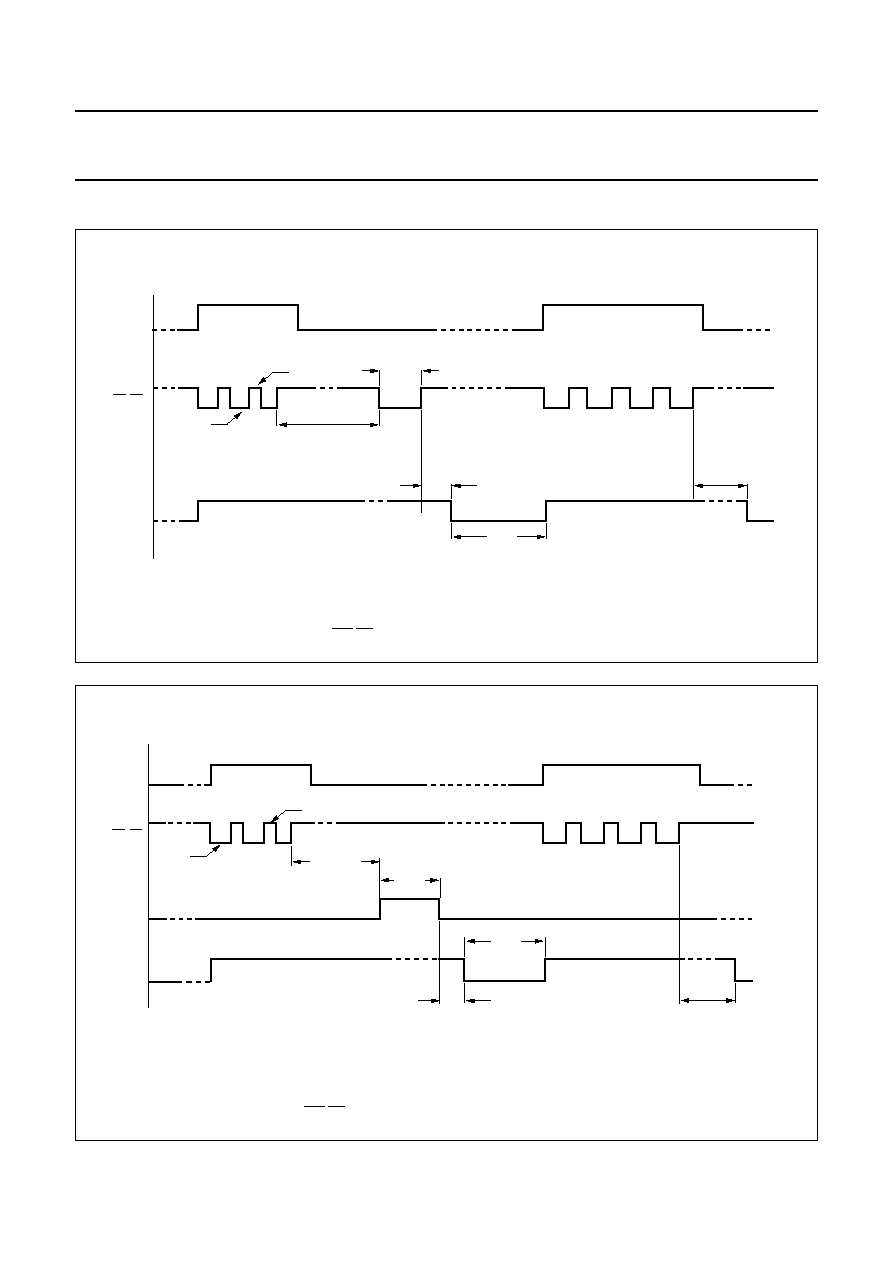
1997 Jan 13
17
Philips Semiconductors
Product specification
Multistandard pulse/tone repertory
diallers/ringers
PCD3332-2; PCD3332-3;
PCD3332-S
handbook, full pagewidth
DIGITS
(3)
(RECALL)
(4)
DMO
DP/FL
MUTE
tm + tidp
tm+ tidp + tholdover
tm
tb
tflash
tidp
tholdover
MBE762
6.1.3.1
Pulse dialling (PTS = ON)
Fig.11 DP/FL, DMO and MUTE timing relationship.
t
holdover
= 80 ms; t
idp
= 840 ms.
t
b
= break time; t
m
= make time; t
idp
= interdigit pause time.
Fig.12 DP/FL, DMO, MUTE and EARTH timing relationship.
t
holdover
= 80 ms; t
idp
= 840 ms.
t
b
= break time; t
m
= make time; t
idp
= interdigit pause time.
handbook, full pagewidth
DIGITS
(3)
(RECALL)
(4)
DP/LF
DMO
EARTH
MUTE
tm + tidp
tm + tidp + tholdover
tholdover
tearth
tidp
tm
tb
MBE763

1997 Jan 13
18
Philips Semiconductors
Product specification
Multistandard pulse/tone repertory
diallers/ringers
PCD3332-2; PCD3332-3;
PCD3332-S
6.1.3.2
DTMF dialling (PTS = OFF)
Fig.13 DP/FL, MUTE and TONE timing relationship.
t
holdover
= 80 ms; t
idp
= 840 ms.
t
idp
= interdigit pause time.
handbook, full pagewidth
DIGITS
TONE
DP/FL
MUTE
tflash
tpause + tholdover
tidp
tholdover
ttone
tpause
(3)
(3)
(4)
(RECALL)
MBE758
Fig.14 TONE, MUTE and EARTH timing relationship.
t
holdover
= 80 ms; t
idp (flash
-
idp)
= 840 ms.
t
idp
= interdigit pause time.
handbook, full pagewidth
DIGITS
TONE
EARTH
MUTE
tearth
tpause + tholdover
tidp
tholdover
ttone
tpause
(3)
(3)
(4)
(RECALL)
MBE759

1997 Jan 13
19
Philips Semiconductors
Product specification
Multistandard pulse/tone repertory
diallers/ringers
PCD3332-2; PCD3332-3;
PCD3332-S
6.1.3.3
Manual dialling
During digit entry, the device immediately starts to transmit
the digit(s). The minimum transmission time is unaffected
by the speed of entry. Transmission continues as long as
further data input has to be processed. Up to 32 digits can
be stored in the redial register.
After the main register overflows, a 10 digits First-In
First-Out register (FIFO) takes over as buffer. After
transmitting the first digit of the FIFO register this position
is automatically cleared to provide space for storing new
data. In this way, the total number of digits which can be
transmitted is unlimited, provided the key-in rate is not
excessive.
If the key-in rate causes both the redial register and FIFO
register to overflow, the PCD3332-2 will return to the
conversation mode and no keyboard entries will be
accepted.
6.1.3.4
Last number redial
If the first key entered is the LNR key, the stored LNR
number is dialled out. LNR can hold a maximum of
32 digits. LNR is inhibited If more than 32 digits are
entered, normal dialling however is continued.
LNR functional examples:
= Go on-hook
= Go off-hook
Table 17 LNR capacity
Table 18 LNR after programming
Table 19 LNR sliding cursor
INPUT
OUTPUT
,
[1], [2], [3], [4], [5], [6], [7], [8], [9], [0], [1], [2], [3],
[4], [5], [6], [7], [8], [9], [0], [1], [2], [3], [4], [5], [6],
[7], [8], [9], [0], [1], [2],
DTMF: 1, 2, 3, 4, 5, 6, 7, 8, 9, 0, 1, 2, 3, 4, 5, 6, 7, 8, 9, 0, 1, 2, 3,
4, 5, 6, 7, 8, 9, 0, 1, 2
.
[LNR],
DTMF: 1, 2, 3, 4, 5, 6, 7, 8, 9, 0, 1, 2, 3, 4, 5, 6, 7, 8, 9, 0, 1, 2, 3,
4, 5, 6, 7, 8, 9, 0, 1, 2
,
[LNR], [0],
DTMF: 1, 2, 3, 4, 5, 6, 7, 8, 9, 0, 1, 2, 3, 4, 5, 6, 7, 8, 9, 0, 1, 2, 3,
4, 5, 6, 7, 8, 9, 0, 1, 2, 0
,
[LNR],
nothing dialled
INPUT
OUTPUT
,
[1], [2], [3], [4], [5],
DTMF: 1, 2, 3, 4, 5
,
[LNR],
DTMF: 1, 2, 3, 4, 5
,
, [STORE] [5], [4], [3], [2], [1], [STORE], [M1],
beep for each entry (confirmation beep)
, [
LNR],
nothing dialled
INPUT (M1 = 1, 2, 3, 4 or 5)
OUTPUT
,
[1], [2], [3], [4], [5], [6], [7], [8], [9], [0],
DTMF: 1, 2, 3, 4, 5, 6, 7, 8, 9, 0
,
[1], [2], [3], [LNR],
DTMF: 1, 2, 3, 4, 5, 6, 7, 8, 9, 0
,
[STORE] [5], [4], [3], [2], [1], [STORE], [M1]
DTMF: 1, 2, 3, 4, 5, 6, 7, 8, 9, 0
,
[M1], Wait for end of dial, [M1],
DTMF: 1, 2, 3, 4, 5, 1, 2, 3, 4, 5
[1], [2], [3], [LNR],
DTMF: 1, 2, 3, 4, 5, 1, 2, 3, 4, 5
[
2], [3], [LNR],
DTMF: 2, 3
[
2], [3], [LNR],
DTMF: 2, 3
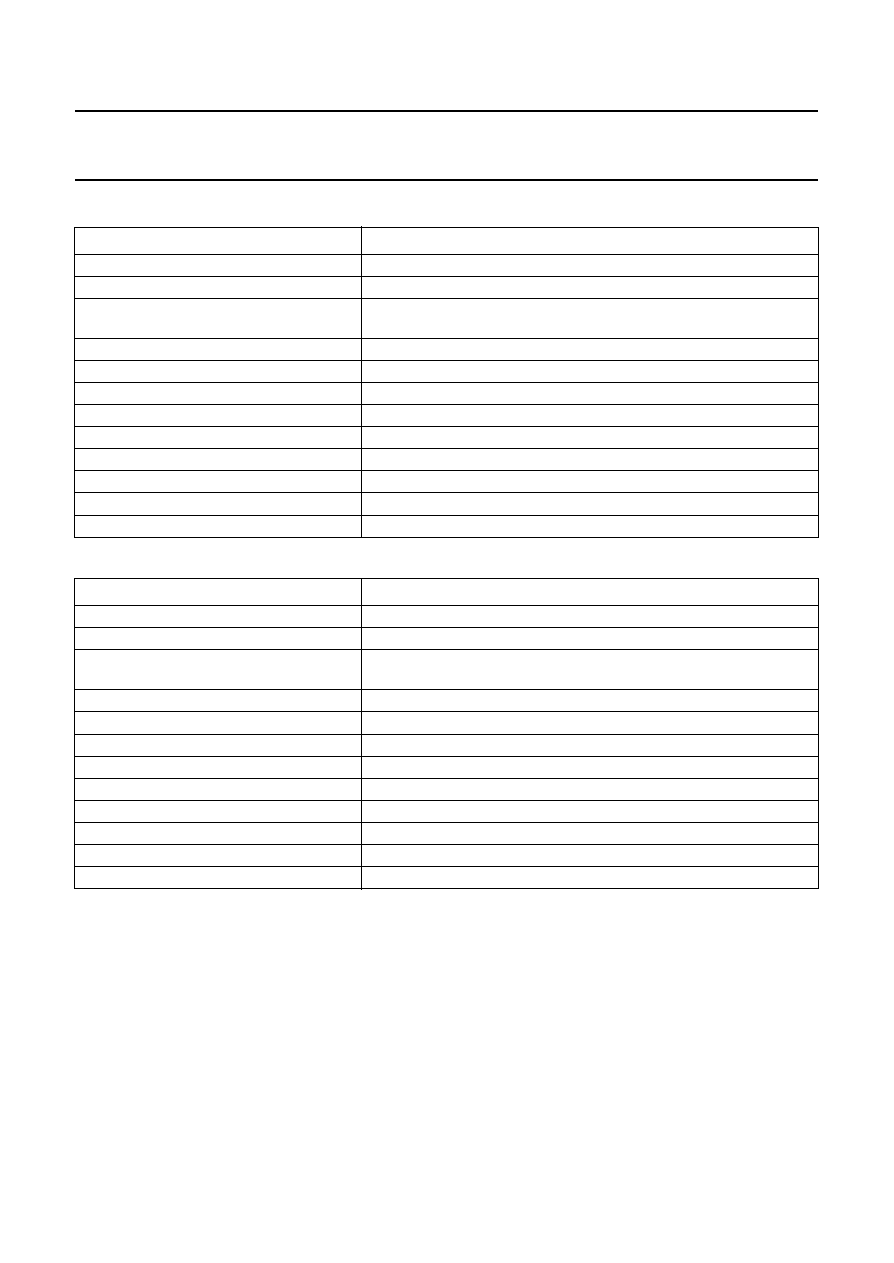
1997 Jan 13
20
Philips Semiconductors
Product specification
Multistandard pulse/tone repertory
diallers/ringers
PCD3332-2; PCD3332-3;
PCD3332-S
Table 20 LNR if
, #, Tone, and recall is entered in DTMF mode
Table 21 LNR if
, #, Tone, and recall is entered in PULSE mode
INPUT
OUTPUT
[1], [2], [
], [3], [4], [Recall], [6], [7],
DTMF: 1, 2,
, 3, 4, Flash, 6, 7
,
[LNR],
DTMF: Flash, 6, 7
[Recall], Wait 0.5 sec, [Recall], Wait 0.5
sec, [Recall], [1], [2], [3],
Flash, Flash, Flash, 1, 2, 3
[LNR],
Flash, 1, 2, 3
[1], [2], [3], [Recall], [3], [2], [1],
1, 2, 3, Flash, 3, 2, 1
[LNR],
Flash, 3, 2, 1
[1], [2], [3], [Recall], [
], [3], [2], [1],
1, 2, 3, Flash,
, 3, 2, 1
[LNR],
, 3, 2, 1
[
], [1], [2], [3], [Recall], [3], [2], [1],
, 1, 2, 3, Flash, 3, 2, 1
[LNR],
Flash, 3, 2, 1
[
], [1], [2], [3], [Recall], [
], [3], [2], [1],
, 1, 2, 3, Flash, 3, 2, 1
[LNR],
Flash, 3, 2, 1
INPUT
OUTPUT
[1], [2], [
], [3], [4], [Recall], [6], [7],
PULSE: 1, 2, DTMF: 3, 4, Earth, PULSE: 6, 7
[
LNR],
PULSE: 1, 2
[Recall], Wait 0.5 sec, [Recall], Wait 0.5
sec, [Recall], [1], [2], [3],
PULSE: Earth, Earth, Earth, 1, 2, 3
[LNR],
PULSE: Earth, 1, 2, 3
[1], [2], [3], [Recall], [3], [2], [1],
PULSE: 1, 2, 3, Earth, 3, 2, 1
[LNR],
PULSE: Earth, 3, 2, 1
[1], [2], [3], [Recall], [
], [3], [2], [1],
PULSE: 1, 2, 3, Earth, DTMF: 3, 2, 1
[LNR],
PULSE: 1, 2, 3
[
], [1], [2], [3], [Recall], [3], [2], [1],
DTMF: 1, 2, 3, Earth, PULSE: 3, 2, 1
[LNR],
PULSE: Earth, 3, 2, 1
[
], [1], [2], [3], [Recall], [
], [3], [2], [1],
DTMF: 1, 2, 3, Earth, 3, 2, 1
[LNR],
DTMF: 1, 2, 3

1997 Jan 13
21
Philips Semiconductors
Product specification
Multistandard pulse/tone repertory
diallers/ringers
PCD3332-2; PCD3332-3;
PCD3332-S
6.1.3.5
Access pause dialling and termination
Access pauses entered during manual dialling or repertory
number storage are not dialled out, but are stored. When
LNR or a repertory number is selected for redial, the
access pauses are dialled out. If at LNR or repertory dial,
an access pause is being dialled out, then depressing the
PAUSE key will terminate the access pause in progress
and dialling will continue at the first non-access pause
digit.
6.1.3.6
Flash/Earth recall
Depending on the option selected (see Table 8),
depressing the Flash key will generate a calibrated
Flash time at output DP/FL, or a calibrated earth time on
the EARTH output. The calibrated earth time is 400 ms,
the flash time is set by diodes as shown in Table 7.
The Flash/Earth will also refer the set to dial mode
selected by the diode option.
6.1.3.7
Data dialling in the pulse dialling mode
If the PCD3332 is initially set to the pulse dial mode
(PTS = ON), depressing the TONE,
or # key will continue
dialling in the DTMF mode. Flash/Earth recall will restore
the pulse dialling mode.
6.1.4
P
ROGRAMMING MODE
The PCD3332 has an on-chip CMOS RAM which can
store up to 10 numbers of 32 digits with a total of 250 digits
(floating memory). If the memory overflows, a warning
beep is generated. If the controller is initially set to the
pulse dial mode, digits can be stored in the pulse dial
and/or in the DTMF mode by depressing key
or # or
using the `change mode' procedure during the store
procedure. This function is best illustrated in Table 22.
6.1.4.1
Memory overflow
A total of 250 digits can be stored. If an attempt is made to
store a number which will bring the total amount of digits
stored to over 250, the TONE output will generate the
memory overflow beeps and the store procedure is
cancelled.
6.1.4.2
Notepad function
In the speech mode, a number can be entered on the
keyboard. This number may be dialled out at the next
off-hook situation by LNR or may be entered in memory.
This function effectively mimics a notepad for a number
passed during a telephone conversation.
6.1.4.3
Repertory and chain dialling
Repertory numbers can be dialled out before or after
manual dialling or LNR, and can be entered one after
another in a chain. However, during transmission of LNR
or a repertory number, a subsequent repertory number is
not accepted. This means that a repertory number can
only be entered if the previous repertory dial or LNR is
ended.
Depending on the MLA diode configuration (see Table 14)
the procedure is as follows:
·
Direct repertory access: M1 to M10
·
Two-key repertory access: MRC_0 to MRC_9.
6.1.5
R
INGER MODE
(PCD3332-2/S)
The PCD3332-2/S has a built-in frequency discriminator
circuit, with CE/FDI being used as the discriminator input.
If the ringer frequency supplied is accepted, a ringer
melody is generated. When the ringer melody sounds, the
ringer volume is adjustable in 4 steps using the
/VOL
-
and #/VOL
+
keys.
Depending on the diode RMS, either a default ringer
melody is selected, or 1 out of 3 ringer melodies may be
selected from the keypad (see Table 12).
6.1.6
R
INGER MODE
(PCD3332-3)
The PCD3332-3 has a built-in frequency discriminator
circuit, with CE/FDI being used as the discriminator input.
If the ringer frequency supplied is accepted, a ringer
melody is generated. When the ringer melody sounds, the
ringer volume is adjustable in 4 steps using the
/VOL
-
and #/VOL
+
keys.
Depending on the diode RFS, 1 of 2 different input ringer
frequency ranges is selected (see Table 13).

1997 Jan 13
22
Philips Semiconductors
Product specification
Multistandard pulse/tone repertory
diallers/ringers
PCD3332-2; PCD3332-3;
PCD3332-S
Fig.15 Ringer response timing and detection.
book, full pagewidth
1/f
ring
CE/FDI
TONE
MBE761
VDD
VSS
trd 1.5/fring

1997 Jan 13
23
Philips Semiconductors
Product specification
Multistandard pulse/tone repertory
diallers/ringers
PCD3332-2; PCD3332-3;
PCD3332-S
Table 22 Key sequences in programming mode
Notes
1. Select [M1] to [M10].
2. Select [0] to [9].
3. Select [M1] to [M3].
KEY SEQUENCE
Programming a repertory location
[STORE] data [STORE] [M1]
(1)
[STORE] data [M1]
(1)
[STORE] data [STORE] [0]
(2)
[STORE] data [STORE] [MRC] [0]
(2)
, and [STORE] data
[STORE] [M1]
(3)
[STORE] data [MRC] [0]
(2)
, and [STORE] data [M1]
(3)
Copy LNR to a repertory location
[STORE] [LNR] [STORE] [M1]
(1)
[STORE] [LNR] [M1]
(1)
[STORE] [LNR] [STORE] [0]
(2)
[STORE] [LNR] [STORE] [MRC] [0]
(2)
, and [STORE] [LNR]
[STORE] [M1]
(3)
[STORE] [LNR] [MRC] [0]
(2)
, and [STORE] [LNR] [M1]
(3)
Clearing a repertory location
[STORE] [M1]
(1)
[STORE] [STORE] [0]
(2)
[STORE] [STORE] [MRC] [0]
(2)
, and [STORE] [STORE] [M1]
(3)
[STORE] [MRC] [0]
(2)
, and [STORE] [M1]
(3)
[STORE] data [MRC] [0]
(2)
, and [STORE] data [M1]
(3)
Notepad programming
[STORE] data [STORE] [LNR]
[STORE] data [LNR]
Clear Notepad
[STORE] [STORE] [LNR]
[STORE] [LNR]

1997 Jan 13
24
Philips Semiconductors
Product specification
Multistandard pulse/tone repertory
diallers/ringers
PCD3332-2; PCD3332-3;
PCD3332-S
7
LIMITING VALUES
In accordance with the Absolute Maximum Rating System (IEC 134).
8
DC CHARACTERISTICS
V
DD
= 1.8 to 6 V; V
SS
= 0 V; T
amb
=
-
25 to +70
°
C; all voltages with respect to V
SS
; f
xtal
= 3.58 MHz; unless otherwise
specified.
SYMBOL
PARAMETER
MIN.
MAX.
UNIT
V
DD
supply voltage
-
0.5
+7.0
V
V
I
all input voltages
-
0.5
V
DD
+ 0.5 V
I
I
DC input current
-
10
+10
mA
I
O
DC output current
-
10
+10
mA
P
tot
total power dissipation
-
125
mW
P
O
power dissipation per output
-
30
mW
I
SS
ground supply current
-
50
+50
mA
T
stg
storage temperature
-
65
+150
°
C
T
j
operating junction temperature
-
90
°
C
SYMBOL
PARAMETER
CONDITIONS
MIN.
TYP.
MAX.
UNIT
Supply
V
DD
supply voltage
operating
2.5
-
6
V
standby
CE = 0
1.0
-
6
V
I
DD(dial)
supply current (dialling mode)
note 1, CE = 1
V
DD
= 3 V; TONE active
-
0.9
1.8
mA
V
DD
= 3 V; TONE not active
-
0.3
0.6
mA
I
DD(conv)
supply current (conversation mode) note 1; CE = 1; V
DD
= 3 V
-
0.2
0.4
mA
I
DD(stb)
supply current (standby mode)
note 2; CE = 0
V
DD
= 1.8 V; T
amb
= 25
°
C;
-
1.0
2.5
µ
A
V
DD
= 1.8 V; T
amb
= 70
°
C;
-
-
10
µ
A
Inputs
V
IL
LOW level input voltage
0
-
0.3V
DD
V
V
IH
HIGH level input voltage
0.7V
DD
-
V
DD
Vtz
I
LI
input leakage current
V
SS
V
I
V
DD
-
1
-
+1
µ
A
Port outputs
I
OL
LOW level output sink current
V
DD
= 3 V; V
O
= 0.4 V
0.7
3.5
-
mA
I
OH
HIGH level pull-up output
source current
V
O
= 2.7 V; V
DD
= 3 V
-
10
-
20
-
µ
A
V
O
= 0 V; V
DD
= 3 V
-
-
100
-
300
µ
A
I
OH1
HIGH level push-pull output
source current
V
DD
= 3 V; V
O
= 2.6 V
-
0.7
-
4
-
mA

1997 Jan 13
25
Philips Semiconductors
Product specification
Multistandard pulse/tone repertory
diallers/ringers
PCD3332-2; PCD3332-3;
PCD3332-S
Notes
1. V
IL
= V
SS
; V
IH
= V
DD
; open-drain outputs connected to V
SS
; all other outputs open; TONE not active, unless
otherwise specified.
2. Crystal connected between XTAL1 and XTAL2; pins T1 and CE/T0 at V
SS
; TONE not active.
3. TONE output requires V
DD
2.5 V.
4. Values are specified for DTMF frequencies only (CEPT).
5. Related to the Low Group Frequency component (CEPT).
9
AC CHARACTERISTICS
V
DD
= 1.8 to 6 V; V
SS
= 0 V; T
amb
=
-
25 to +70
°
C; all voltages with respect to V
SS
; unless otherwise specified.
TONE output (notes 3 and 4)
V
HG(RMS)
High Group Frequency voltage.
Voltage of higher frequency
component for DTMF (RMS value)
158
181
205
mV
V
LG(RMS)
Low Group Frequency voltage.
Voltage of lower frequency
component for DTMF (RMS value)
125
142
160
mV
frequency deviation
-
0.6
-
0.6
%
V
DC
DC voltage level
-
0.5V
DD
-
V
Z
o
output impedance
-
100
500
G
v
pre-emphasis of group
1.5
2.0
2.5
dB
THD
total harmonic distortion
T
amb
= 25
°
C; note 5
-
25
-
dB
Power-on-reset
V
POR
Power-on-reset level
1.5
2.0
2.5
V
Oscillator
g
m
transconductance
V
DD
= 5 V
0.2
0.4
1.0
mS
R
F
feedback resistor
0.3
1.0
3.0
M
SYMBOL
PARAMETER
CONDITIONS
MIN.
TYP.
MAX.
UNIT
t
r
rise time all outputs
V
DD
= 5 V; T
amb
= 25
°
C; C
L
= 50 pF
-
30
-
ns
t
f
fall time all outputs
-
30
-
ns
SYMBOL
PARAMETER
CONDITIONS
MIN.
TYP.
MAX.
UNIT
f
f
/
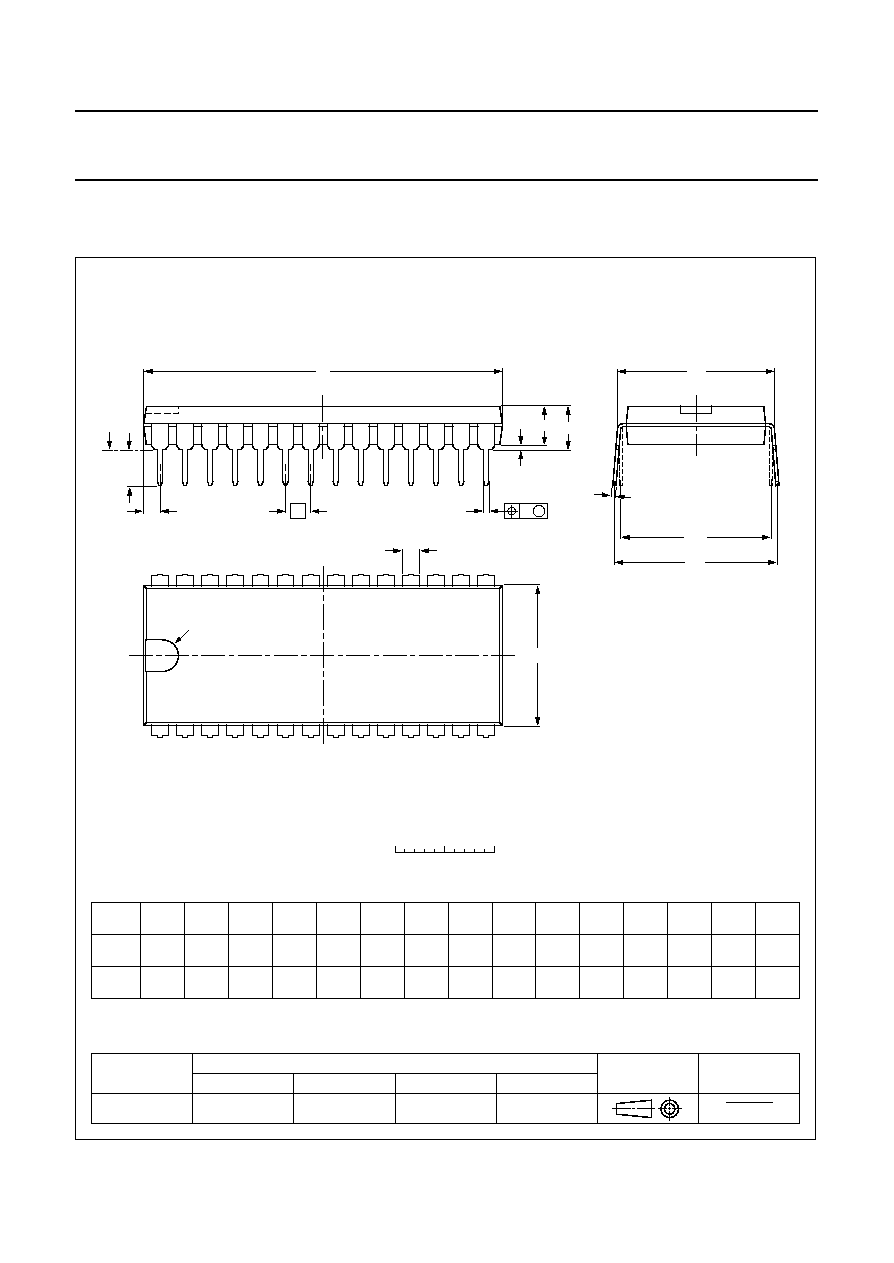
1997 Jan 13
26
Philips Semiconductors
Product specification
Multistandard pulse/tone repertory
diallers/ringers
PCD3332-2; PCD3332-3;
PCD3332-S
10 PACKAGE OUTLINES
UNIT
A
max.
1
2
b
1
(1)
(1)
(1)
c
D
E
w
e
M
H
L
REFERENCES
OUTLINE
VERSION
EUROPEAN
PROJECTION
ISSUE DATE
IEC
JEDEC
EIAJ
mm
inches
DIMENSIONS (inch dimensions are derived from the original mm dimensions)
SOT117-1
92-11-17
95-01-14
A
min.
A
max.
b
Z
max.
M
E
e
1
1.7
1.3
0.53
0.38
0.32
0.23
36.0
35.0
14.1
13.7
3.9
3.4
0.25
2.54
15.24
15.80
15.24
17.15
15.90
1.7
5.1
0.51
4.0
0.066
0.051
0.020
0.014
0.013
0.009
1.41
1.34
0.56
0.54
0.15
0.13
0.01
0.10
0.60
0.62
0.60
0.68
0.63
0.067
0.20
0.020
0.16
051G05
MO-015AH
M
H
c
(e )
1
M
E
A
L
seating plane
A
1
w
M
b
1
e
D
A
2
Z
28
1
15
14
b
E
pin 1 index
0
5
10 mm
scale
Note
1. Plastic or metal protrusions of 0.25 mm maximum per side are not included.
handbook, full pagewidth
DIP28: plastic dual in-line package; 28 leads (600 mil)
SOT117-1
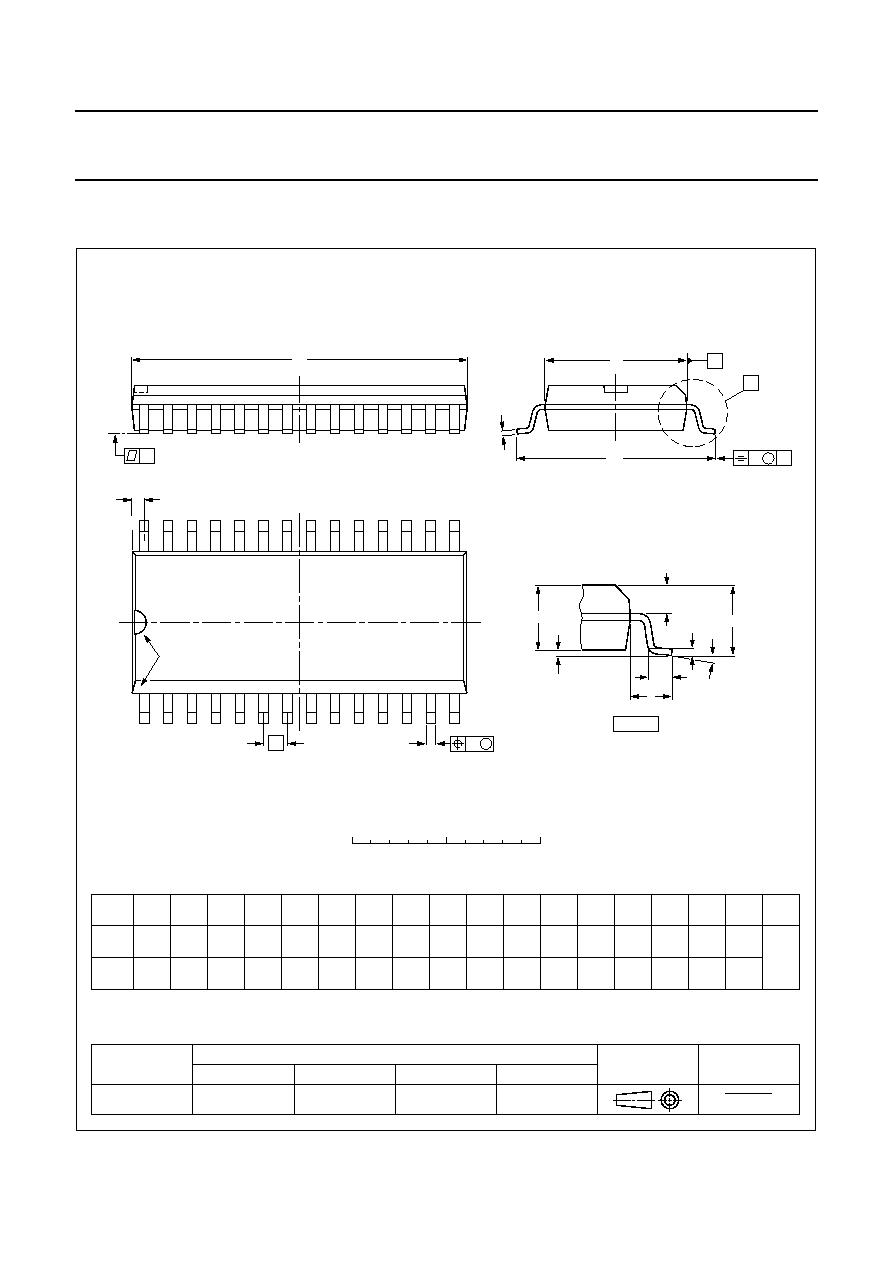
1997 Jan 13
27
Philips Semiconductors
Product specification
Multistandard pulse/tone repertory
diallers/ringers
PCD3332-2; PCD3332-3;
PCD3332-S
UNIT
A
max.
A
1
A
2
A
3
b
p
c
D
(1)
E
(1)
(1)
e
H
E
L
L
p
Q
Z
y
w
v
REFERENCES
OUTLINE
VERSION
EUROPEAN
PROJECTION
ISSUE DATE
IEC
JEDEC
EIAJ
mm
inches
2.65
0.30
0.10
2.45
2.25
0.49
0.36
0.32
0.23
18.1
17.7
7.6
7.4
1.27
10.65
10.00
1.1
1.0
0.9
0.4
8
0
o
o
0.25
0.1
DIMENSIONS (inch dimensions are derived from the original mm dimensions)
Note
1. Plastic or metal protrusions of 0.15 mm maximum per side are not included.
1.1
0.4
SOT136-1
91-08-13
95-01-24
X
14
28
w
M
A
A
1
A
2
b
p
D
H
E
L
p
Q
detail X
E
Z
c
L
v
M
A
e
15
1
(A )
3
A
y
0.25
075E06
MS-013AE
pin 1 index
0.10
0.012
0.004
0.096
0.089
0.019
0.014
0.013
0.009
0.71
0.69
0.30
0.29
0.050
1.4
0.055
0.42
0.39
0.043
0.039
0.035
0.016
0.01
0.25
0.01
0.004
0.043
0.016
0.01
0
5
10 mm
scale
SO28: plastic small outline package; 28 leads; body width 7.5 mm
SOT136-1

1997 Jan 13
28
Philips Semiconductors
Product specification
Multistandard pulse/tone repertory
diallers/ringers
PCD3332-2; PCD3332-3;
PCD3332-S
11 SOLDERING
11.1
Introduction
There is no soldering method that is ideal for all IC
packages. Wave soldering is often preferred when
through-hole and surface mounted components are mixed
on one printed-circuit board. However, wave soldering is
not always suitable for surface mounted ICs, or for
printed-circuits with high population densities. In these
situations reflow soldering is often used.
This text gives a very brief insight to a complex technology.
A more in-depth account of soldering ICs can be found in
our
"IC Package Databook" (order code 9398 652 90011).
11.2
DIP
11.2.1
S
OLDERING BY DIPPING OR BY WAVE
The maximum permissible temperature of the solder is
260
°
C; solder at this temperature must not be in contact
with the joint for more than 5 seconds. The total contact
time of successive solder waves must not exceed
5 seconds.
The device may be mounted up to the seating plane, but
the temperature of the plastic body must not exceed the
specified maximum storage temperature (T
stg max
). If the
printed-circuit board has been pre-heated, forced cooling
may be necessary immediately after soldering to keep the
temperature within the permissible limit.
11.2.2
R
EPAIRING SOLDERED JOINTS
Apply a low voltage soldering iron (less than 24 V) to the
lead(s) of the package, below the seating plane or not
more than 2 mm above it. If the temperature of the
soldering iron bit is less than 300
°
C it may remain in
contact for up to 10 seconds. If the bit temperature is
between 300 and 400
°
C, contact may be up to 5 seconds.
11.3
SO
11.3.1
R
EFLOW SOLDERING
Reflow soldering techniques are suitable for all SO
packages.
Reflow soldering requires solder paste (a suspension of
fine solder particles, flux and binding agent) to be applied
to the printed-circuit board by screen printing, stencilling or
pressure-syringe dispensing before package placement.
Several techniques exist for reflowing; for example,
thermal conduction by heated belt. Dwell times vary
between 50 and 300 seconds depending on heating
method. Typical reflow temperatures range from
215 to 250
°
C.
Preheating is necessary to dry the paste and evaporate
the binding agent. Preheating duration: 45 minutes at
45
°
C.
11.3.2
W
AVE SOLDERING
Wave soldering techniques can be used for all SO
packages if the following conditions are observed:
·
A double-wave (a turbulent wave with high upward
pressure followed by a smooth laminar wave) soldering
technique should be used.
·
The longitudinal axis of the package footprint must be
parallel to the solder flow.
·
The package footprint must incorporate solder thieves at
the downstream end.
During placement and before soldering, the package must
be fixed with a droplet of adhesive. The adhesive can be
applied by screen printing, pin transfer or syringe
dispensing. The package can be soldered after the
adhesive is cured.
Maximum permissible solder temperature is 260
°
C, and
maximum duration of package immersion in solder is
10 seconds, if cooled to less than 150
°
C within
6 seconds. Typical dwell time is 4 seconds at 250
°
C.
A mildly-activated flux will eliminate the need for removal
of corrosive residues in most applications.
11.3.3
R
EPAIRING SOLDERED JOINTS
Fix the component by first soldering two diagonally-
opposite end leads. Use only a low voltage soldering iron
(less than 24 V) applied to the flat part of the lead. Contact
time must be limited to 10 seconds at up to 300
°
C. When
using a dedicated tool, all other leads can be soldered in
one operation within 2 to 5 seconds between
270 and 320
°
C.

1997 Jan 13
29
Philips Semiconductors
Product specification
Multistandard pulse/tone repertory
diallers/ringers
PCD3332-2; PCD3332-3;
PCD3332-S
12 DEFINITIONS
13 LIFE SUPPORT APPLICATIONS
These products are not designed for use in life support appliances, devices, or systems where malfunction of these
products can reasonably be expected to result in personal injury. Philips customers using or selling these products for
use in such applications do so at their own risk and agree to fully indemnify Philips for any damages resulting from such
improper use or sale.
Data sheet status
Objective specification
This data sheet contains target or goal specifications for product development.
Preliminary specification
This data sheet contains preliminary data; supplementary data may be published later.
Product specification
This data sheet contains final product specifications.
Limiting values
Limiting values given are in accordance with the Absolute Maximum Rating System (IEC 134). Stress above one or
more of the limiting values may cause permanent damage to the device. These are stress ratings only and operation
of the device at these or at any other conditions above those given in the Characteristics sections of the specification
is not implied. Exposure to limiting values for extended periods may affect device reliability.
Application information
Where application information is given, it is advisory and does not form part of the specification.

1997 Jan 13
30
Philips Semiconductors
Product specification
Multistandard pulse/tone repertory
diallers/ringers
PCD3332-2; PCD3332-3;
PCD3332-S
NOTES

1997 Jan 13
31
Philips Semiconductors
Product specification
Multistandard pulse/tone repertory
diallers/ringers
PCD3332-2; PCD3332-3;
PCD3332-S
NOTES

Internet: http://www.semiconductors.philips.com
Philips Semiconductors a worldwide company
© Philips Electronics N.V. 1997
SCA53
All rights are reserved. Reproduction in whole or in part is prohibited without the prior written consent of the copyright owner.
The information presented in this document does not form part of any quotation or contract, is believed to be accurate and reliable and may be changed
without notice. No liability will be accepted by the publisher for any consequence of its use. Publication thereof does not convey nor imply any license
under patent- or other industrial or intellectual property rights.
Netherlands: Postbus 90050, 5600 PB EINDHOVEN, Bldg. VB,
Tel. +31 40 27 82785, Fax. +31 40 27 88399
New Zealand: 2 Wagener Place, C.P.O. Box 1041, AUCKLAND,
Tel. +64 9 849 4160, Fax. +64 9 849 7811
Norway: Box 1, Manglerud 0612, OSLO,
Tel. +47 22 74 8000, Fax. +47 22 74 8341
Philippines: Philips Semiconductors Philippines Inc.,
106 Valero St. Salcedo Village, P.O. Box 2108 MCC, MAKATI,
Metro MANILA, Tel. +63 2 816 6380, Fax. +63 2 817 3474
Poland: Ul. Lukiska 10, PL 04-123 WARSZAWA,
Tel. +48 22 612 2831, Fax. +48 22 612 2327
Portugal: see Spain
Romania: see Italy
Russia: Philips Russia, Ul. Usatcheva 35A, 119048 MOSCOW,
Tel. +7 095 755 6918, Fax. +7 095 755 6919
Singapore: Lorong 1, Toa Payoh, SINGAPORE 1231,
Tel. +65 350 2538, Fax. +65 251 6500
Slovakia: see Austria
Slovenia: see Italy
South Africa: S.A. PHILIPS Pty Ltd., 195-215 Main Road Martindale,
2092 JOHANNESBURG, P.O. Box 7430 Johannesburg 2000,
Tel. +27 11 470 5911, Fax. +27 11 470 5494
South America: Rua do Rocio 220, 5th floor, Suite 51,
04552-903 São Paulo, SÃO PAULO - SP, Brazil,
Tel. +55 11 821 2333, Fax. +55 11 829 1849
Spain: Balmes 22, 08007 BARCELONA,
Tel. +34 3 301 6312, Fax. +34 3 301 4107
Sweden: Kottbygatan 7, Akalla, S-16485 STOCKHOLM,
Tel. +46 8 632 2000, Fax. +46 8 632 2745
Switzerland: Allmendstrasse 140, CH-8027 ZÜRICH,
Tel. +41 1 488 2686, Fax. +41 1 481 7730
Taiwan: Philips Semiconductors, 6F, No. 96, Chien Kuo N. Rd., Sec. 1,
TAIPEI, Taiwan Tel. +886 2 2134 2870, Fax. +886 2 2134 2874
Thailand: PHILIPS ELECTRONICS (THAILAND) Ltd.,
209/2 Sanpavuth-Bangna Road Prakanong, BANGKOK 10260,
Tel. +66 2 745 4090, Fax. +66 2 398 0793
Turkey: Talatpasa Cad. No. 5, 80640 GÜLTEPE/ISTANBUL,
Tel. +90 212 279 2770, Fax. +90 212 282 6707
Ukraine: PHILIPS UKRAINE, 4 Patrice Lumumba str., Building B, Floor 7,
252042 KIEV, Tel. +380 44 264 2776, Fax. +380 44 268 0461
United Kingdom: Philips Semiconductors Ltd., 276 Bath Road, Hayes,
MIDDLESEX UB3 5BX, Tel. +44 181 730 5000, Fax. +44 181 754 8421
United States: 811 East Arques Avenue, SUNNYVALE, CA 94088-3409,
Tel. +1 800 234 7381
Uruguay: see South America
Vietnam: see Singapore
Yugoslavia: PHILIPS, Trg N. Pasica 5/v, 11000 BEOGRAD,
Tel. +381 11 625 344, Fax.+381 11 635 777
For all other countries apply to: Philips Semiconductors, Marketing & Sales Communications,
Building BE-p, P.O. Box 218, 5600 MD EINDHOVEN, The Netherlands, Fax. +31 40 27 24825
Argentina: see South America
Australia: 34 Waterloo Road, NORTH RYDE, NSW 2113,
Tel. +61 2 9805 4455, Fax. +61 2 9805 4466
Austria: Computerstr. 6, A-1101 WIEN, P.O. Box 213,
Tel. +43 1 60 101, Fax. +43 1 60 101 1210
Belarus: Hotel Minsk Business Center, Bld. 3, r. 1211, Volodarski Str. 6,
220050 MINSK, Tel. +375 172 200 733, Fax. +375 172 200 773
Belgium: see The Netherlands
Brazil: see South America
Bulgaria: Philips Bulgaria Ltd., Energoproject, 15th floor,
51 James Bourchier Blvd., 1407 SOFIA,
Tel. +359 2 689 211, Fax. +359 2 689 102
Canada: PHILIPS SEMICONDUCTORS/COMPONENTS,
Tel. +1 800 234 7381
China/Hong Kong: 501 Hong Kong Industrial Technology Centre,
72 Tat Chee Avenue, Kowloon Tong, HONG KONG,
Tel. +852 2319 7888, Fax. +852 2319 7700
Colombia: see South America
Czech Republic: see Austria
Denmark: Prags Boulevard 80, PB 1919, DK-2300 COPENHAGEN S,
Tel. +45 32 88 2636, Fax. +45 31 57 1949
Finland: Sinikalliontie 3, FIN-02630 ESPOO,
Tel. +358 9 615800, Fax. +358 9 61580/xxx
France: 4 Rue du Port-aux-Vins, BP317, 92156 SURESNES Cedex,
Tel. +33 1 40 99 6161, Fax. +33 1 40 99 6427
Germany: Hammerbrookstraße 69, D-20097 HAMBURG,
Tel. +49 40 23 53 60, Fax. +49 40 23 536 300
Greece: No. 15, 25th March Street, GR 17778 TAVROS/ATHENS,
Tel. +30 1 4894 339/239, Fax. +30 1 4814 240
Hungary: see Austria
India: Philips INDIA Ltd, Shivsagar Estate, A Block, Dr. Annie Besant Rd.
Worli, MUMBAI 400 018, Tel. +91 22 4938 541, Fax. +91 22 4938 722
Indonesia: see Singapore
Ireland: Newstead, Clonskeagh, DUBLIN 14,
Tel. +353 1 7640 000, Fax. +353 1 7640 200
Israel: RAPAC Electronics, 7 Kehilat Saloniki St, TEL AVIV 61180,
Tel. +972 3 645 0444, Fax. +972 3 649 1007
Italy: PHILIPS SEMICONDUCTORS, Piazza IV Novembre 3,
20124 MILANO, Tel. +39 2 6752 2531, Fax. +39 2 6752 2557
Japan: Philips Bldg 13-37, Kohnan 2-chome, Minato-ku, TOKYO 108,
Tel. +81 3 3740 5130, Fax. +81 3 3740 5077
Korea: Philips House, 260-199 Itaewon-dong, Yongsan-ku, SEOUL,
Tel. +82 2 709 1412, Fax. +82 2 709 1415
Malaysia: No. 76 Jalan Universiti, 46200 PETALING JAYA, SELANGOR,
Tel. +60 3 750 5214, Fax. +60 3 757 4880
Mexico: 5900 Gateway East, Suite 200, EL PASO, TEXAS 79905,
Tel. +9-5 800 234 7381
Middle East: see Italy
Printed in The Netherlands
417027/1200/03/pp32
Date of release: 1997 Jan 13
Document order number:
9397 750 01079































